Usborne Science Puzzle Adventures: Doctor Genius and the Mad Scientists - The Flask of Doom
In my previous Usborne entries I always suffered from a faint sense of inadequacy, quite aside from the discomfort of stretching the definition of a “screencap” on a LiveJournal community that, like the platform itself, is effectively defunct. There were dozens of these things, so where do I get off doing only a handful, unlike all those other nostalgia blogs which race through dozens of children’s and teen books from the 90s? That’s why I’m starting a new series dedicated to documenting the entire Usborne Science Puzzle Adventures series! All two of them.
The awkwardly- and lengthily-titled Usborne Science Puzzle Adventures came, like Usborne Solve It Yourself, around the time the original Usborne Puzzle Adventures series drew to a close - 1996. As I’ve speculated before, Usborne had pretty much saturated the market with its original thirty-odd Puzzle Adventures, so the chances are they were on the lookout for anything they could spin as new and exciting and original. Enter Clive Gifford, author of a heck of a lot (like seriously, hundreds) of educational and puzzle books for children, who whether by commission or on his own account produced two books headlined “Doctor Genius and the Mad Scientists,” which were made into the inaugural titles in the new Usborne Science Puzzle Adventures series.
Unfortunately for Gifford and Usborne, these ended up being the only books in the Usborne Science Puzzle Adventures series. We can only speculate about what happened, but given that these books sell themselves as both Usborne Science Puzzle Adventures and Doctor Genius and the Mad Scientists, it’s a fair bet they were only meant to be the first of various USPA sub-series by different authors. But clearly, it didn’t take off. Let’s see if we can determine just why things didn’t work out.

Maybe it’s only me, but just for starters I don’t find the updated, much cartoonier and goofier art style particularly appealing. Graham Round’s rather rough-edged and idiosyncratic artwork of the early Usborne Puzzle Adventures really made those books; Peter Wingham’s art back on The Dark, Dark Knight was tolerable, but there’s something very manufactured and designed-by-committee about Geo Parkin’s work here. I’m also not a big fan of the “let’s just not bother to include a background” school of design. It’s functional enough, I guess. We can reasonably infer that those goofs in the back are our heroes, Doctor Genius and his Mad Scientists, which is usually the sort of name you’d give to a bunch of villains but nope, as we’ll find out, the carefully-individualised Mad Scientists are definitely the heroes here. At least we have a villain with some class. Monocle, ascot... uh, that’s probably meant to be a monogrammed smoking jacket but it looks a lot more like a dressing gown, let’s be honest. This is a villain who gets that dreadful modern ennui where one doesn’t see anything going on in the day that’s worth getting dressed for. Only 90s kids will get this.
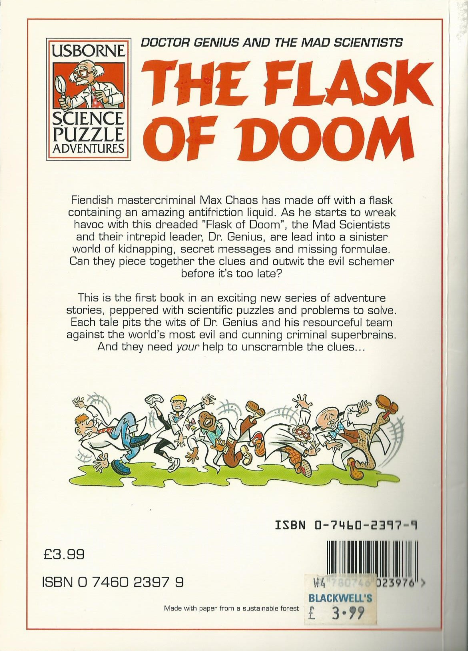
Fiendish mastercriminal Max Chaos! Hahaha, wow. There is not one thing remotely subtle about any of the words in that phrase, either individually or together. Credit where credit’s due, they tell us exactly what we’re in for. Also credit where credit’s due, the premise of the antifriction liquid is actually fairly original, if not even remotely doom-laden, and you can easily see how it ties into the (sshh, whisper it) educational aspect, because yes, surprise, these are secretly educational books! Probably nobody ever learned anything useful from Escape from Blood Castle or Who Shot the Sheriff? - at least, I hope not - but the aspirations of Usborne Science Puzzle Adventures were not disguised very well. Maybe that’s why they didn’t succeed, perhaps; too obviously educational, no matter how thrilled they sounded about being “the first book in an exciting new series of adventure stories”.
Still, let’s give them a chance. After all, Dr. Genius and the Mad Scientists need your help! Because not one of them is smarter than a ten year old.
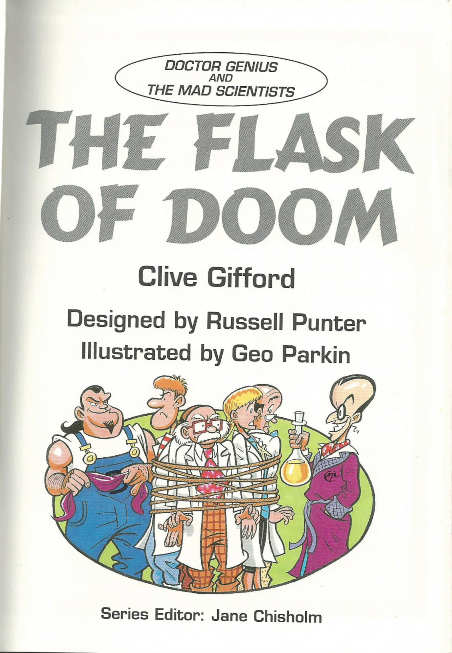
I checked my old files, and not one of these people worked on any of the previous Usborne puzzle books I’ve documented. They even threw out series editor and author of the early books Gaby Waters! Even Who Shot the Sheriff? had her on the team! The classics may have been silly as anything, but they at least had charm. Oh well, at least there’s some of that classic Escape from Blood Castle flavour of seeing our protagonists captured and tied up. Even though they clearly outnumber the villains more than twice over. You’d think they could at least split up and run away.
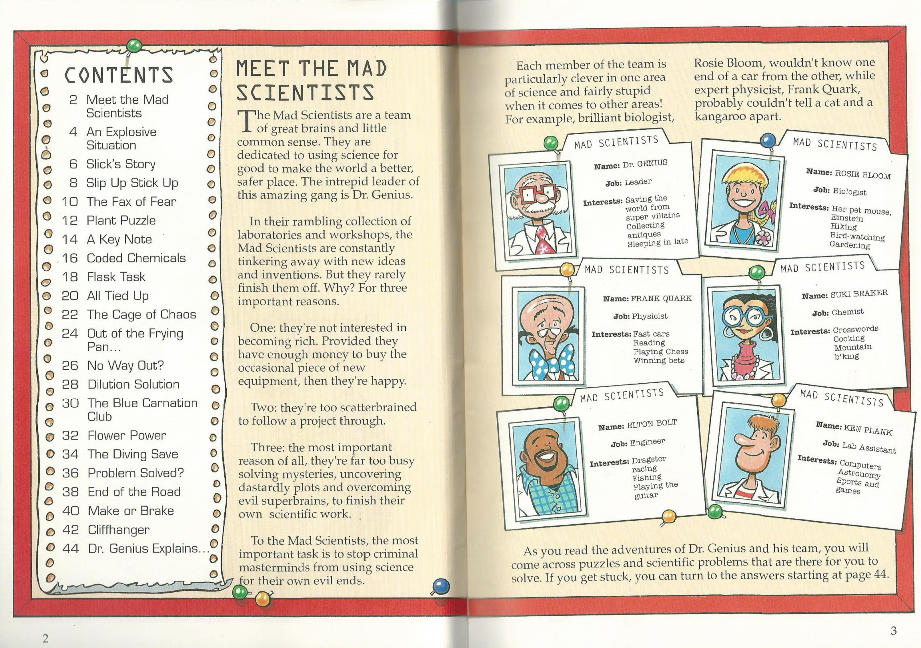
At last, it’s time to meet our five heroes! …Our six heroes! Bizarrely, Suki Beaker is completely missing from both the front and back covers and the title page. I really don’t know why they’ve tried to erase her, but there it is. Way to fall at the first hurdle on representation, Usborne.
Anyway! These are our six heroes, covering a broad spectrum of gender, ethnicity, body type, even age. It is all very convenient but we shall not choose to question it. What we should probably question is their actual commitment to science. Sure, the interdisciplinary approach has a lot going for it, but the upshot is that every one of them is working with five other people who know absolutely nothing about their field, apparently even less than the man on the street. Not only do I know one end of a car from another, just about, I can also tell a cat from a kangaroo. Somebody should let me onto this team. Oh, right, they kind of have, I’m the reader and the person who solves all their problems for them. This is handy, as these people are so incompetent that I don’t even know how their lab stays open. The story openly admits that they never actually complete any of their projects, so frankly I assume one of them must already be rich for their lab to have any funding at all. Either that, or they’re getting money under the table from tobacco companies or Big Pharma. But that seems unlikely, as fighting crime appears to be the one thing they are good at. Shame it doesn’t pay the bills.
At any rate, here they all are, carefully-profiled with jobs and interests, and we’ll just see how many of those interests ever actually come up in the story. Will Dr. Genius ever actually collect any antiques or sleep in late? …Does Dr. Genius even have a formal position at this laboratory? “Leader” isn’t a job or a scientific specialism, and nor is it the best person on the team to be sleeping in late all the time. Well, he is getting on a bit, I suppose.
Frank Quark is a ruthless sportsman and gambler who likes playing chess and winning bets. Okay, probably he’s the one keeping the Mad Scientists afloat, then.
Elton Bolt likes dragster racing and fishing, presumably not at the same time. Don’t both of these interests go at completely different paces? Then again I guess you could say the same for Quark’s hobbies of reading and fast cars, so I guess I’ll let it slide.
Rosie Bloom’s interests are all conceivably biology-related, so no complaints there.
Suki Beaker - chemistry, cooking, okay, but… mountain biking? These are some pretty active scientists. Well, when you spend all your time fighting crime instead of performing experiments, it means you end up doing a lot of fieldwork.
Ken Plank is a lab assistant, and considering what this lab is like, either he’s the most useless of all of them or the smartest of the lot. Incidentally, on the cover of the second Usborne Science Puzzle Adventures, he displaces Dr. Genius in the series title box. Still could be either the smartest or most useless.
…Also, I just realised that Dr. Genius is the only one of these idiots with an actual doctorate. Is this even a real laboratory? Are these people qualified?
Also, by the way, as the bottom of page 3 implies, we’re not getting hints this time around, just answers. But I liked the hints! Well, I guess they often are either not helpful at all or too helpful by half. Still, it’s just one more step away from the tried-and-tested formula which, no matter how much I mocked it, I deeply enjoyed. Ah well. Let’s see how this goes.
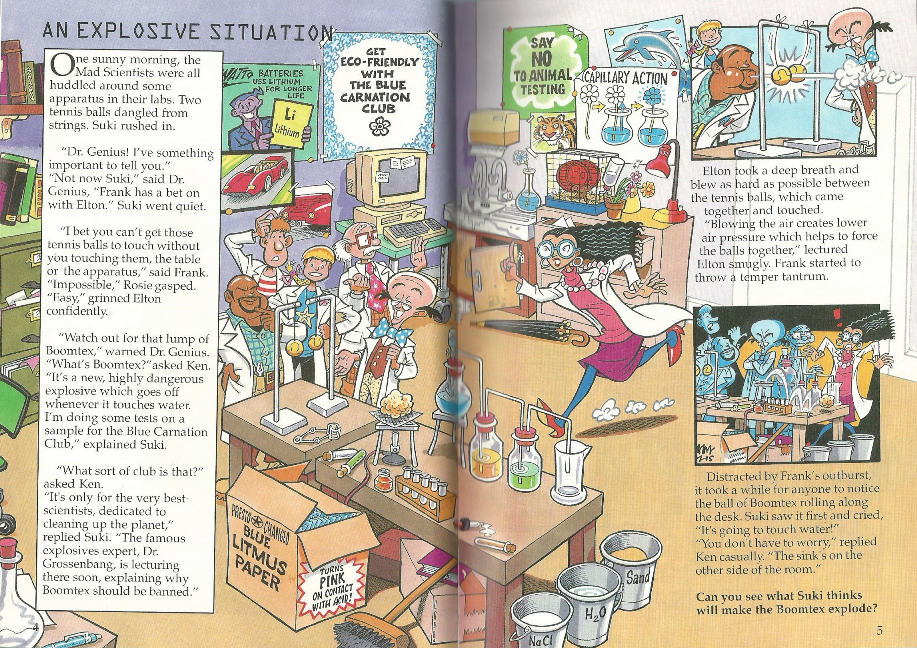
Like Suki’s even the most important character on the first real page, what the heck. Dr. Genius barely says anything. Though the real star of the show is Dr. Quark’s incredibly smug expression… though we will later see that this book is very good at, if anything at all, smug expressions.
One sunny morning, our heroes can’t tell that it’s sunny or morning as they’re cooped up in a windowless lab engaged in that most scientific of scientific pursuits, petty gambling. Petty gambling right next to the experiment involving a legally controversial explosive substance. Suki runs in to tell Dr. Genius something, but the Boomtex was her experiment, so she’s just left the dangerous explosive material lying around unattended in a precarious position, in the vicinity of the very chemical which causes it to explode. I can’t wait for the third title in the series, Dr. Genius Versus The Safety Inspectors Of Closure!
Before we proceed with the puzzle, let us first appreciate the amount of detail packed into the background of this scene. The pictures of fast cars and wild animals. A poster for their favourite club. And, just in case this was sounding too much like a teenager’s bedroom, litmus paper, swiftly explained and doubtless to be crucial to some future puzzle. As for this page’s puzzle, it’s more or less a… well, not a tutorial, but more of a test. Do you know one of the most basic and commonly-known scientific details about water?
Oh. Or you could just recognise the bucket full of clear fluid and cheat, I guess.
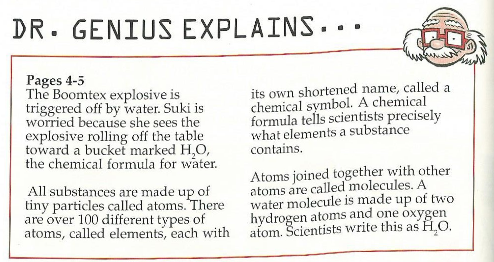
Water is the answer. The thing which Suki has seen which she thinks will make the Boomtex explode is water, as explained on the opposite side of the page. To the book’s credit, “Dr. Genius Explains” is a good title for this section as the reason why water’s chemical formula is H2O is clearly explained rather than just stated without context, so good on it. If they’d wanted to be really clever, they could have tricked you here and had a substance which looks like water but actually has a different chemical name, and that’s why it’s just what Suki thinks she’s seen - but she’s a chemist, she knows what she’s doing, unlike everyone else, who don’t. And thus the book proceeds with its first explosion. That’s sure to appeal to the kids!
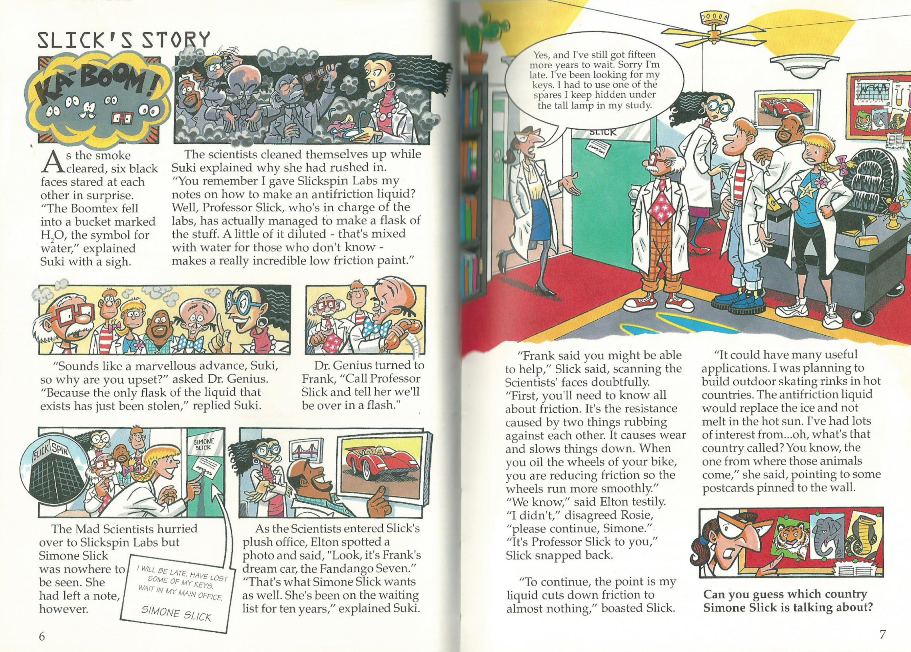
Don’t worry, though, the explosion was of no consequence whatsoever, it was merely a humorous interlude before we get onto more hard science, including rendering the answers page more or less immediately redundant.
Suki continues to be the most important character despite not being featured anywhere on the cover by revealing that she is the inventor of the almighty antifriction formula which this book is all about, and which it is apparently a big deal to have the only flask of stolen, despite the fact that they can just make more, and if they can’t then what made them think it would be so easy to turn into an internationally successful product? Simone Slick clearly has some money to splash around, given that she owns a chemistry lab, is on the waiting list for a super fasto posh beep beep vroom vroom speedywheels, and can afford to wear a pair of glasses about the same size as her entire head. Here, have a geography quiz. Geography is like science, right?
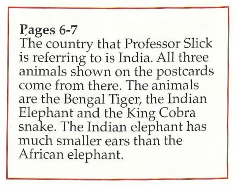
The way I learnt it is that Indian elephants have ears shaped like India, and African elephants have ears shaped like Africa. Note also that the basic outline of that tiger is identical to the one pictured on page 5, so I’m guessing Geo Parkin only had the one reference image. …It also occurs to me that this puzzle is totally irrelevant to the plot, but it was the end of a double-page so we had to have one.
I wonder how many pages it will be before we meet a character who isn’t wearing a lab coat?
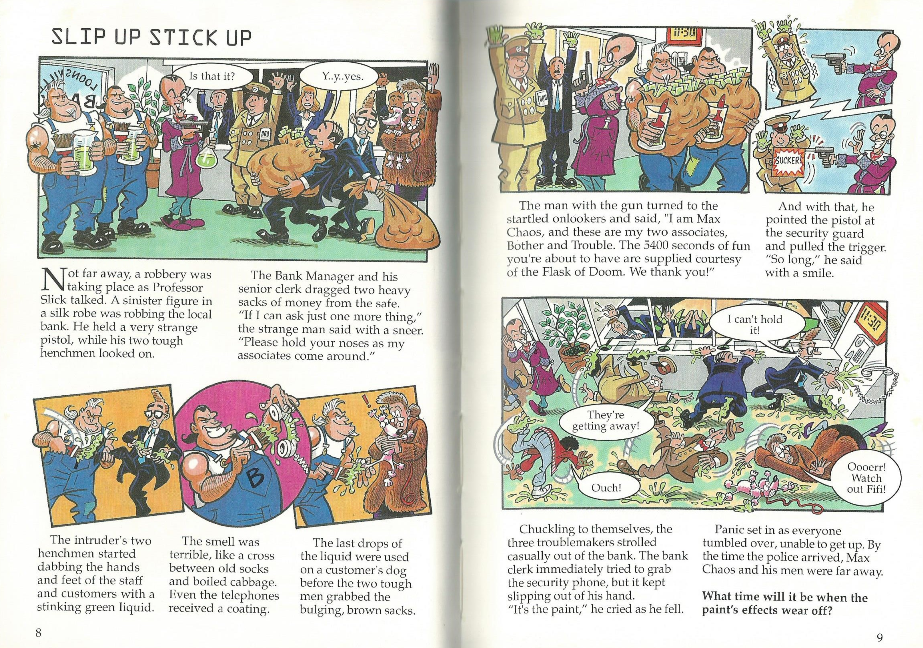
Oh, no more. Here they are. Max Chaos sure didn’t hang about when it came to entering the narrative. He didn’t even bother to get dressed; look, he’s still in his slippers.
I admit, Max Chaos’s goofy, absurd, slapstick plan tickles me. I like it a lot. It feels like something out of the 1960s Batman or something equally camp. So I will overlook obvious logical problems like why the bank had no form of panic button, backroom staff, passers-by, any way of alerting the police to what is a fairly public robbery that would have taken some time to complete until after the comically-named thieves have departed. I won’t even complain that Max Chaos’s fake gun becomes meaningless the moment he fires it - why didn’t they jump him then, and what does he plan to do when the next bank he robs already knows he doesn’t have real weapons? It could’ve at least squirted more antifriction formula - and for that matter, antifriction liquid that can make people fall over isn’t exactly my idea of a “Flask of Doom.” But no. I will overlook these things for the sake of the joke.
What I will not overlook is the fact that, once again, the puzzle in question isn’t based on science. It’s mathematics.
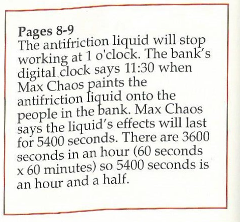
I cracked it as 60 x 90, myself, but you get the picture. Say, couldn’t they have called for help from passers-by? But I already said I would let it slide. I don’t have a choice. With that antifriction liquid in play, of course everything’s going to slide!

Meanwhile, back at Slickspin Labs, the scientific experts are still being given a lecture on basic friction. Then they’re told to get lost. Maybe they should come back when they all have actual doctorates. It’s very noble of Rosie to eschew the reward money, but university doesn’t come cheap these days!
Over the page, Suki continues to be the most important character in this story as an old man grumbles over what he reads in the newspaper. Dr. Genius, remind me why this is your problem again? Suki, why are you giving the impression that the only reason you care about this is because you feel personally insulted by Professor Slick? She has an actual degree. Leave this to the professionals, please. Max Chaos is clearly having a whale of a time, though. He really is a genius. Only one day later, and he’s already successfully gotten away with two separate wicked schemes, much though the hard-hitting investigative journalism of The News Herald can’t make the connection between a stolen antifriction formula and a top international goalkeeper with butterfingers, and also a dreadful team who let a whole twenty-one goals get near him in the first place. Okay, maybe Max Chaos isn’t the only problem here.
Whoops, we’ve hit the end of a page. Time to shoehorn in an insultingly easy puzzle that still has nothing to do with science.

Professor Slick gets results. Less than twenty-four hours and she’s already nailed that friction restorer. See, Suki, this is what you could do if you had actual qualifications. Also she’s being kidnapped by people who are polite enough to permit her to leave a series of undoubtedly cryptic clues which she can’t simply send in a fax because reasons. First-draft puzzle, first-draft plot…
Also, while I cannot claim to have spent time in many offices while the fax machine was still relevant, wouldn’t it make as much or more sense if the printer trouble was on the Mad Scientists’ end…?

Rather than calling the police, the Mad Scientists decide to investigate the kidnapping-in-process by entering a darkened building at midnight. What did they expect to happen, honestly. They didn’t even turn the lights on. Meanwhile the pungent odour of the Flask of Doom has been swiftly downgraded, the better for our heroes to fall quite literally into a trap - albeit one which makes no sense according to the orientation of the rooms as depicted in the panels, which show that Professor Slick’s office lies at the end of a long straight corridor which not only slopes downwards but has a flight of stairs at the end and no turn-offs within which a villainous henchman could hide to subsequently close the door behind the Mad Scientists without themselves being caught in the antifriction formula. But I didn’t read this book to nitpick. (I absolutely read this book to nitpick.)
Oh by the way, Suki’s out of the story again because she’s working on the friction restorer, and in fairness, while she’s late to the party on that, the fact that the sole inventor of the friction restorer has just been kidnapped right after finishing it suggests that it might not be around anymore. (Alright, probably the henchmen had some friction restorer, and that’s how they got to the door to close it on the Mad Scientists. Quit nitpicking my nitpicking! It’s rude.)
Anyway, finally a puzzle which requires some knowledge of biology… although the real a puzzle why the ransackers threw the lamp around but didn’t touch the plants that indicate its location. Actually, I’m not even sure there’s room for the lamp where it’s clearly originally supposed to have gone…

All the plants? I guess the cactus might just about to be said to be doing so, but we can’t really tell about the daffodils. I guess that’s clutching at straws, though; they’re probably meant to be red herrings to make the actual solution slightly less obvious. The important thing is that we learned something. Although in fact you can only have learnt something if you were unable to solve the puzzle, but if you could solve it already then you didn’t learn anything. This is the main flaw of this sub-series; its actually scientific puzzles are more a test of whether you already know something or not, and whether you do or you don’t then it’s not really a puzzle as there is nothing much to really work out…
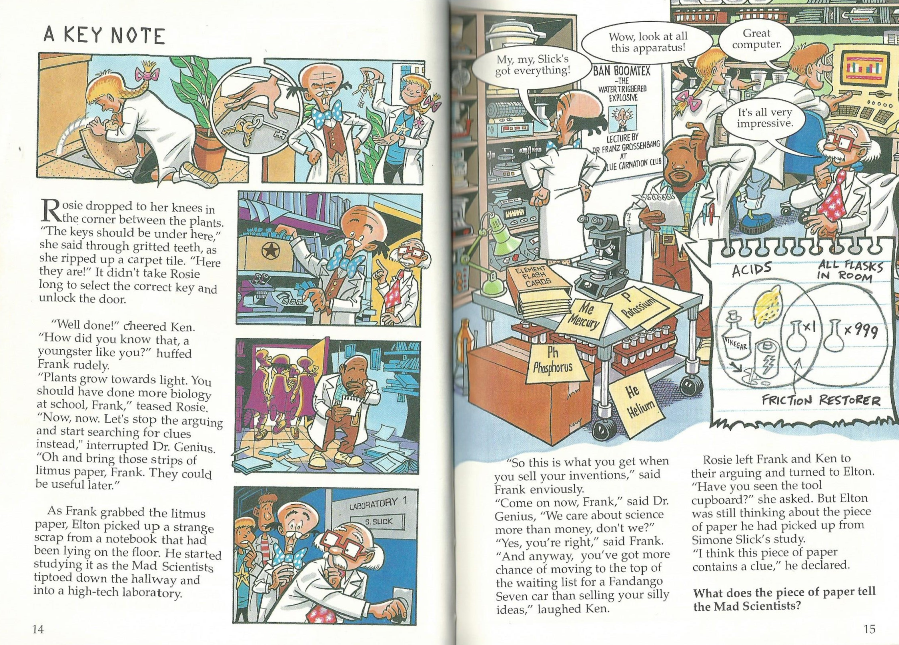
I have a vague idea that I was confused by this whole scenario of the hidden key when I was a child, because there was clearly nothing where the lamp should have been except floor - but the key is, of course, hidden under a floor tile. I assume Rosie only figuratively “ripped” the carpet up, given that Professor Slick had been using that spare just the previous day. Presumably her real keys were not lost but stolen by Max Chaos and his gang as they waited for her to complete the friction restorer, a theory substantiated by their subsequent ability to lock the Mad Scientists in, but if that’s the case, would she really have hidden them again?
Anyway, despite coming all this way to visit Professor Slick’s office, we now leave her office, walk back over the harmless antifriction formula, and snoop around Slick’s lab to gaze enviously at her high-tech equipment. Wow, turns out that, if you actually sell your amazing inventions, you can afford top-of-the-line equipment which allows you to perform more sophisticated experiments with more refined results! Pfft, no real scientist cares about that rubbish, clearly. More and more I think Dr. Genius and his gang are just being funded by corporate interests…
As Rosie marvels at paper coffee mugs and I reflect that even scientists with more academic qualifications than Dr. Genius still need element flash cards, we are asked to puzzle out the meaning of this clue, presumably one of the ones Dr. Slick carefully hid whilst struggling with her kidnappers. We might as well, as I’m not sure what everyone else is meant to be doing. So, what does this piece of paper tell the Mad Scientists? Well… how to make the friction restorer, I guess? Is that answer allowed? No, because it’s wrong.
Now, I’ll ‘fess up that on my rereading here I messed up this puzzle pretty hard, primarily because I kind of forgot how Venn diagrams work, despite really liking Venn diagrams. But I was just so convinced that part of the puzzle of this page involved working out what the battery acid was, as the element flashcards appeared to clearly direct you to the Lithium poster on pages 4-5; there’s even a little arrow pointing you to the battery acid on the note, and the water is also muddied by the fact that there are very clearly not nine-hundred-and-ninety-nine flasks in the room. (In fact, the room the Mad Scientists are in right now is completely irrelevant to the plot - they could be in a corridor.) So I really thought this was some set of instructions, whereby if you combine 999 of all the flasks with these specific acids pictured then voila… but if that were the correct reading, the two circles would have to overlap completely, I think, because it would require all of both sets rather than a subset of each, which is the real solution here.
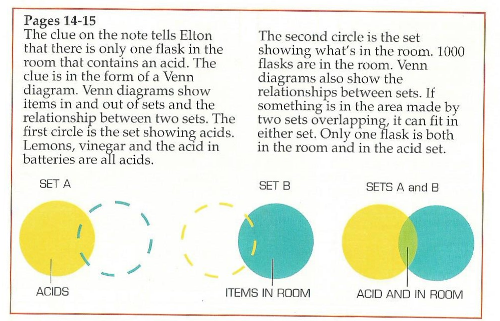
So. You have 999 flasks on the wall, 999 flasks, you take one down and pass it around and if it’s an acid then it’s friction restorer. Still, I do think there are a lot of very odd things about this puzzle - the obviously false specification of 999 flasks, for instance, bearing in mind that neither the illustrations nor the narration have yet presented us with a room filled to bursting with flasks, and indeed which won’t turn up for another couple of pages. Similarly, I think there’s the redundancy of the fact that each set is both labelled and illustrated, which implies that the details are important when in fact they aren’t at all (yet). On top of that, there’s the way that the puzzle only really boils down to “It’s an acid,” which makes all the rest of the flasks redundant… A lot of the trouble just boils down to the puzzle only making sense in the context of an area we haven’t seen yet but don’t know that we haven’t seen yet. …Insert funny comment here?
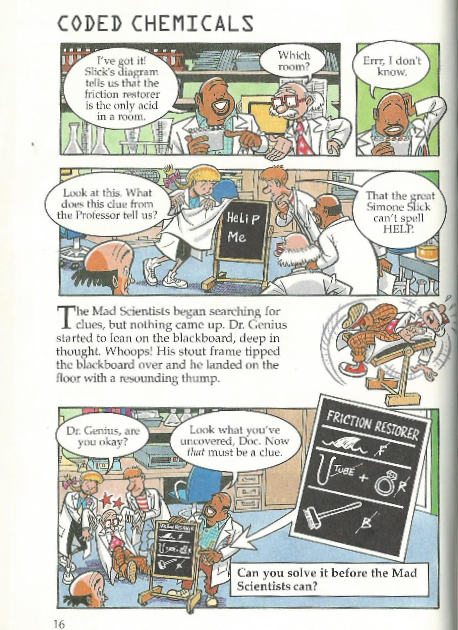
It doesn’t happen very often, but the next two pages each contain an independent puzzle (sort of), so we’re taking them in turn. Incidentally, it’s interesting, from a point of view of plot construction, when Usborne Puzzle Adventures have to give away the solution to a puzzle on the very following page. Sometimes the answers are just too specific to disguise, but a lot of the time it’s possible to write over it. Not here.
So, we have a not very subtle clue, but ignore that for a minute, because the real puzzle is on the other side of the blackboard. Thanks for stumbling across it, almost literally, Dr. Genius! Let’s not just mention that it would have been equally easy to discover this tricky puzzle just by, you know, walking around the blackboard, which is in the middle of the room. Rosie and Ken are clearly side-on to it, you’d have thought they could see that there was something on the other side as well, even if it was upside-down. Oh - but I keep forgetting, it’s actually a fundamental point of their characterisation that our heroes are complete idiots. Makes a change! (I also note here that the text describes Dr. Genius as “stout,” but his build is actually very similar to everyone else save Elton, which makes me wonder how close a conference there was between the author and illustrator on this one.)
You’ve probably done puzzles like this before. It’s a simple rebus puzzle - an introductory one, really, as every stage directly clues you in to the fact that we’re actually thinking about the words these images represent. I do think it’s faintly classless that, once again, part of it depends upon a place we haven’t heard of yet. Also that, in the context of the previous puzzle, this puzzle is once again quite unnecessary.

You see my point, right? We’ve never heard of a testing room, and for that matter, I wouldn’t begrudge anyone who didn’t know much about test tubes to read the first part of the middle line as “TUBE,” leaving you with a puzzle about a ting room. They couldn’t have slipped a reference to test tubes somewhere earlier in the story? In a book about scientists? Wait, what did this puzzle have to do with science again. Just that it had a test tube in it…?
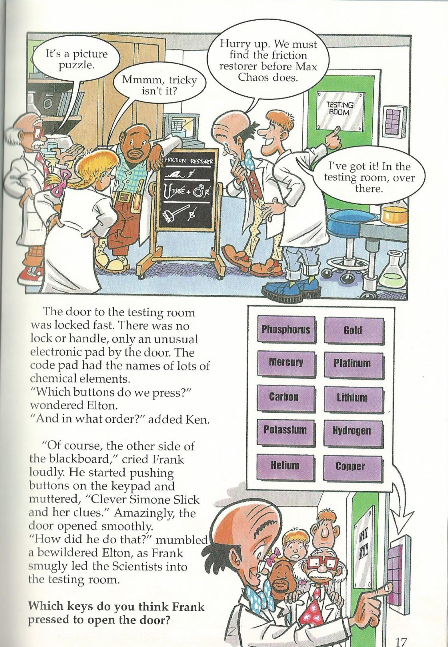
Of course, the easy way to solve this puzzle is to let your eyes slide slightly to the right, where we get the answer straightaway, and since this puzzle is once again not about science then it’s fitting that the answer is delivered by the character who knows the least about science. So he’s useful for something!
They just had nothing for this page, though, did they. Not only did they have to split these two pages up into two puzzles, they had to basically give the answer away. We could have been spared being reminded about the other side of the blackboard, which we first saw about a minute ago. We could’ve stood for the elements on the silly keypad to be ones without really obvious chemical symbols that you could feasibly just ignore. The only one you couldn’t flat-out guess is which element the P stood for.
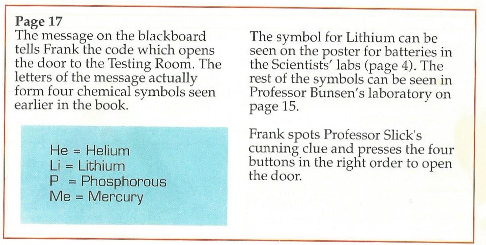
I’d say that it was a nice job for actually hiding lithium way back in the book… but it’s negated this being the first time we’ve ever read the name “Professor Bunsen.” Do they proofread these things at all?
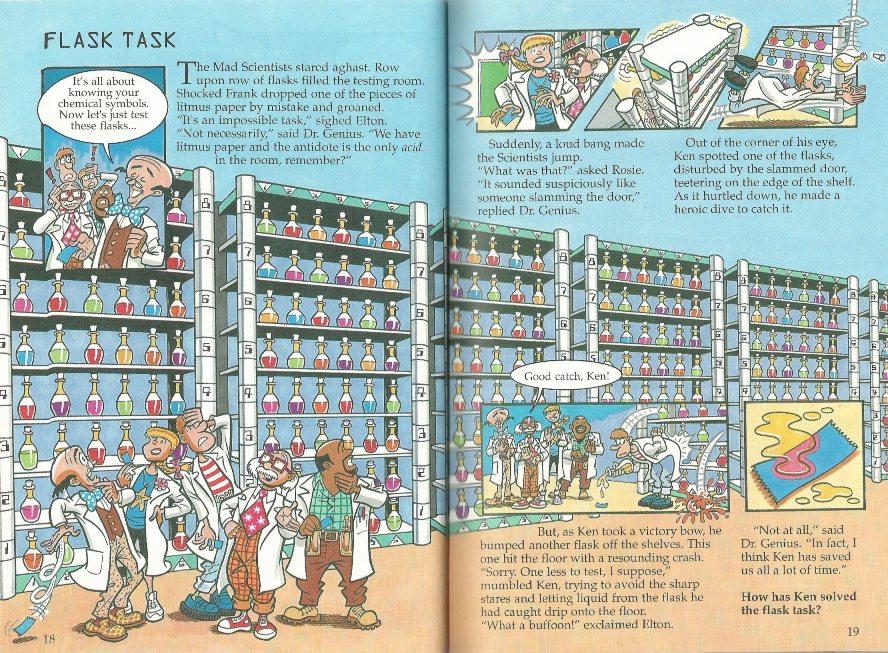
Here’s where the 999 flasks come in. Six by eight, forty-eight, so probably around twenty sets of shelves total, twenty-one - no, twenty-two - to account for the remainder… If they were planning on storing near-on a thousand flasks, I’d have thought they’d have gone for a five by ten model. Wait, hold on, one of the illustrations shows the shelves are double-sided, so that’s ninety-six per shelf for eleven sets of shelves. Okay, that’s actually a lot more mangeable than I figured, you could fit all this in a much smaller room than I had anticipated. Especially when I realised that I’d multiplied an extra ten into my original equation and thought there were over two hundred sets of shelves… It’s a good thing these aren’t Usborne Maths Puzzle Adventures! Which didn’t exist, but I’d have snapped them up if they did. But I guess they’d only have been all about science. And speaking of science, what makes this a “testing room” again?
The door slams yet again. You ever get the feeling our heroes are maybe being herded around just a bit? A bit fishy, especially considering it seems unlikely, after all, that the villains have the friction restorer after all, since it appears to be hidden in this room. What villains hang around the scene of a kidnapping despite almost certainly suspecting that their victim had alerted people on the outside? Villains who know full well that the Mad Scientists aren’t nearly practical enough to think about calling the police, that’s who.
I’d really like to complain about the contrivance of the outrageous stroke of fortune our heroes suffer on this page, but… you know, if the friction restorer was jammed onto the shelves at the last minute as a hiding-place, I guess it might be a bit off-balance. Though frankly it looks like a bit of a casualty of design as much as anything else, as one good bump’d to any of those shelves would be enough to bring down nearly a hundred chemicals. I guess Slickspin Labs are no more practical-minded than the Mad Scientists…
Anyway, you know how litmus paper works. Even if you didn’t and hadn’t read anything in the rest of the book, the page once again basically explains itself. No wonder they didn’t put any hints in the back!
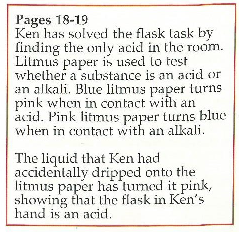
Pretty basic stuff, let’s hurry onto the inevitable capture of our gullible heroes.
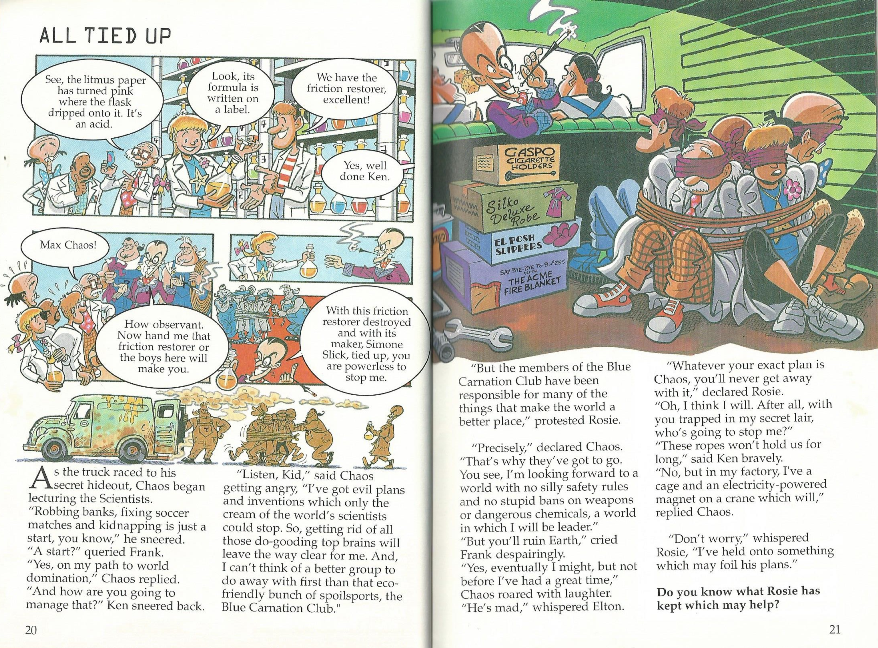
Well, what a surprise. (Incidentally, the art on the title page isn’t just recycled from any of the images here or on a future page, indicating that the illustrator knowingly redrew not two but three separate pictures that ignored one of the book’s main characters. Good job!) As you will have surmised, this is one of many, many stories in which the villain relies on the idiot heroes to do all his work for him, which in this instance means solving puzzles. Now, I personally thought there was a real chance Simone Slick was working for Max Chaos and that was how she’d had time to leave all these subtle-as-anything clues, but no, the deception was the obvious one, and our heroes walked right into it, as heroes always do.
Not that Max Chaos seems all that much more competent than everyone else. The fact that he thinks world domination is achievable puts him straight into the realms of clichéd insanity. He boasts about destroying that friction restorer (whoops, I guess the villains didn’t already have it after all, so those plot holes from earlier are back), but you’d have thought it might be handy for him to have some defence against his own superweapon, and more than that, you’d have thought if he intended to destroy it he’d just throw it on the floor rather than holding onto it and walking about with yet another flask clutched tight in the hand he isn’t using to smoke, though it now occurs to me that the fact that someone is smoking in a children’s book dates this thing more than anything else in the story. What’s in that cigarette, anyway. Is it some substance which accounts for Max’s rigid, manic grin? Well, at least he’s enjoying himself, even if he hasn’t noticed that out here in the real world nobody with real power is lifting even a finger to stop the world’s biggest chemicals and arms manufacturers from doing whatever they want. Funny jokes!
Now, let’s have another puzzle which isn’t strictly speaking related to science, though I guess you can make an argument that detail-oriented observation to gather empirical evidence is of the most fundamental scientific import. Whatever you believe, please comb through this page for a tiny background detail which is so easy to overlook that it’s almost like an art mistake. No, it’s not Chaos’s supply of spare costumes, though Frank could pull off a wizard impersonation if you asked me. No, it’s not Ken’s bizarre needle-soled shoes. Nor is it the hidden trick for distinguishing which henchman is Trouble and which is Bother. It’s actually the kind of puzzle I quite like in an Usborne Puzzle Adventure, really.
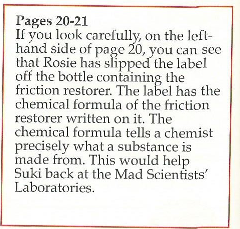
Please. Suki is far too proud to accept such shortcuts.
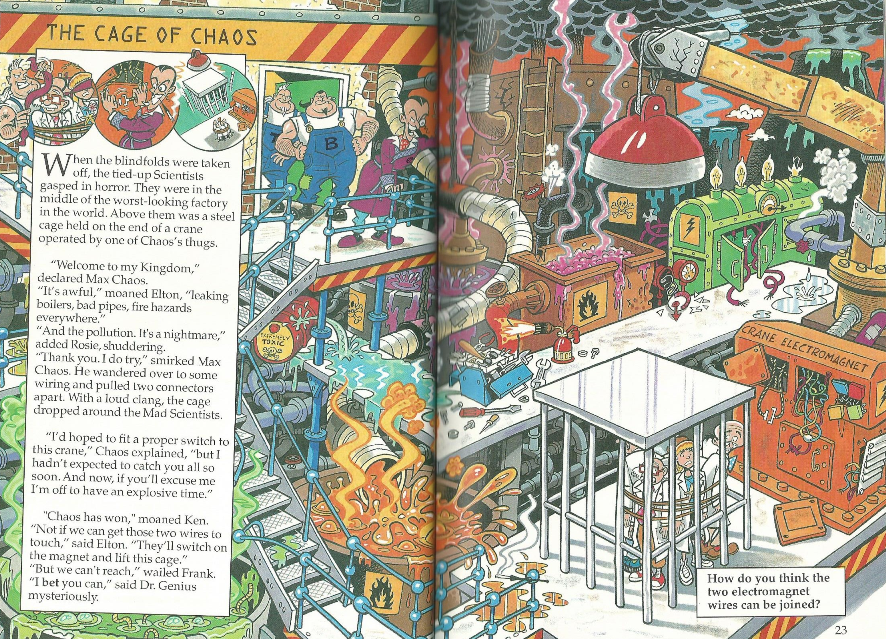
Okay, I’ll give Geo Parkin this. He was asked to draw the worst-looking factory in the world, and boy, did he deliver. The amount of detail crammed into this page is on a par with some of the better pages of Escape from Blood Castle. Fair play to him, he did a good job. With that said, I would question the Mad Scientists’ idea of what makes an awful factory. You know what I see here? Zero workers. Nobody is being underpaid, exploited, and exposed to dangerous conditions here. Well, our heroes aside, but it’s not like they’re here to work, they’re just here to die. I mean, be imprisoned forever. It’s an interesting choice of imprisonment. The magnetic qualities of steel are, in the first place, somewhat variable depending on its composition, and if the cage isn’t fixed to the floor then with a certain amount of wriggling about then the Mad Scientists could probably just push it over. So, the death trap is about as secure as the rest of the factory, then? Also, please note that if that crane is such a powerful magnet, then it should also have had a strong magnetic effect upon anything metal upon our heroes’ bodies. I hope Dr. Genius doesn’t have a pacemaker.
Now that the villains have left our heroes to their own devices in an unbelievably dangerous setting, this seems like the best time for the lead character to be unnecessarily cryptic.
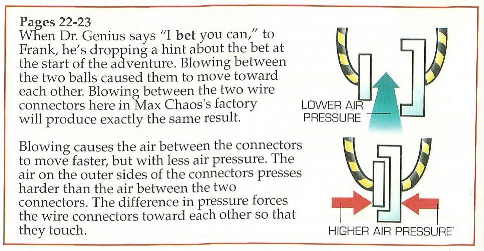
The solution is based upon scientific principles, and was established earlier in the story? At last, things are starting to look up for this book!
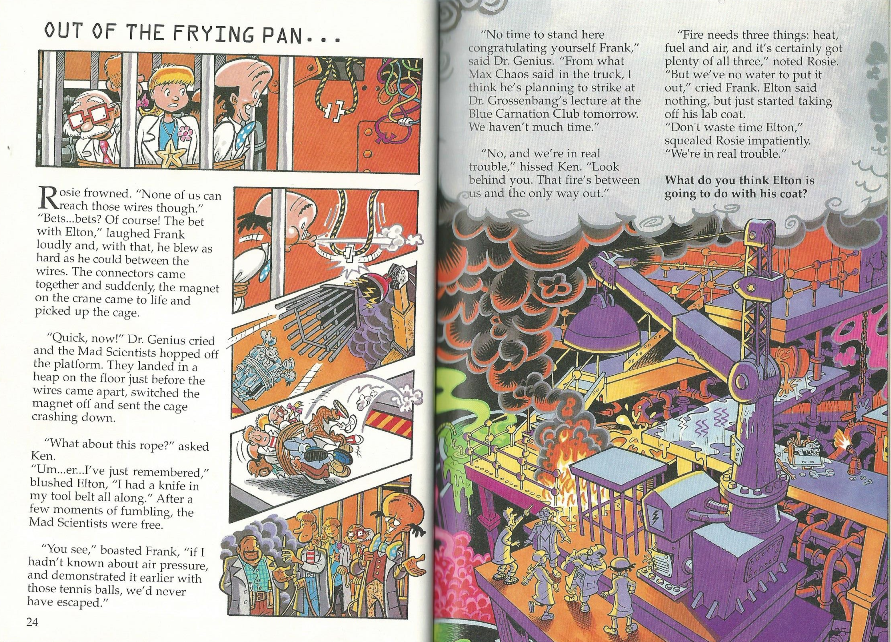
Now that the ropes are off, I feel this is a good time to mention, again to his credit, that Geo Parkin kept the orientation of the Mad Scientists in the rope bundle entirely consistent, even in the out-of-sequence illustration on the title page. (He’s been consistent with which side Chaos’s monocle is on, too.) With that said, his choice did betray some favouritism, as Dr. Genius and Rosie were nearly always centre-stage, but to be honest, they’re my favourite designs too… but so is Elton, and he’s just been a hemisphere for the past few pages. This design choice coincides with Elton’s brain being elsewhere, too, as he reveals that he could have freed them all at any time. Our heroes! Again! They are not very good at what they do. Also, despite Frank’s boast that he was responsible for them getting away with this trick, he was infuriated at the start of the book when Elton beat him at his own game, so in actuality he was totally unnecessary to this escape effort.
Suddenly a fire erupts that’s conveniently between the Mad Scientists and the exit! Actually, I say “conveniently,” but if you look back at the previous page you’ll see that Geo Parkin thought of that too and set up a slightly improbable way of timing it to start at just the right time and place. In fact, this whole illustration is consistent with the previous page, just drawn from another angle - so it’s not even recycled art! Maybe this could still become a good book after all. Now, Rosie, if you could just introduce how fire burns and then squeal uselessly when someone tries to directly remove one of the things necessary for a fire to burn.
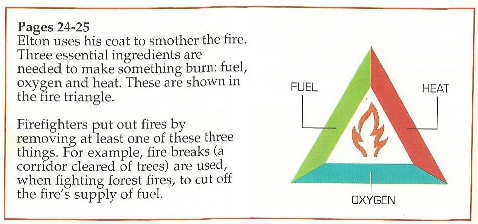
The… fire triangle? Never heard of it, but apparently it’s a thing. Sounds like a less glamorous Ring of Fire, or possibly a musical instrument for daredevils. Hmph, back in my day we didn’t need a triangle to teach us about fire - wait, this book is from back in my day.

Everyone except Dr. Genius sacrifices their scientific credentials to the flames, and not a moment too soon. They also sacrifice their most important clue for defeating Max Chaos, completely invalidating a previous puzzle. Clap. Clap. Clap. Truly stunning work, as always. How many evil plots had these people defeated in the past, did you say? Oh, you didn’t? How surprising.
(By the by, this page too has a subtle hidden detail that’s bound to be important later, so don’t miss it.)
Now, you’re probably wondering why I’ve only shown the one page here. Before we get to the next page, I’d like to talk about mazes for a minute. Mazes are one of my favourite kinds of puzzle from the many children’s puzzle books I read when I was young. Below is a maze from Escape from Blood Castle. Mazes are an opportunity for an illustrator to demonstrate their particular talents and style. Even without another puzzle laid on top of it, this maze would be challenging on visual detail alone.

And below here is a scan from an excellent maze puzzle book, Animal Mazes, that I owned as a child and still possess a copy of. It’s no coincidence that it’s another Usborne book, but as you can probably tell from the text, it is pitched at a younger age group than The Flask of Doom. The mazes of this book are majestic and overwhelming. When you get a book like this as a child, it changes you. They don’t make them like this anymore.

Here’s a maze from The Puzzling Puzzles, a supplementary volume to Lemony Snicket’s A Series of Unfortunate Events. …Okay, perhaps this isn’t quite so legitimate as it first appears - but there is still a genuine goal and a genuine challenge, if you look for it.

…And below is the 27th page from Usborne Science Puzzle Adventures #1: Dr. Genius and the Mad Scientists - The Flask of Doom.
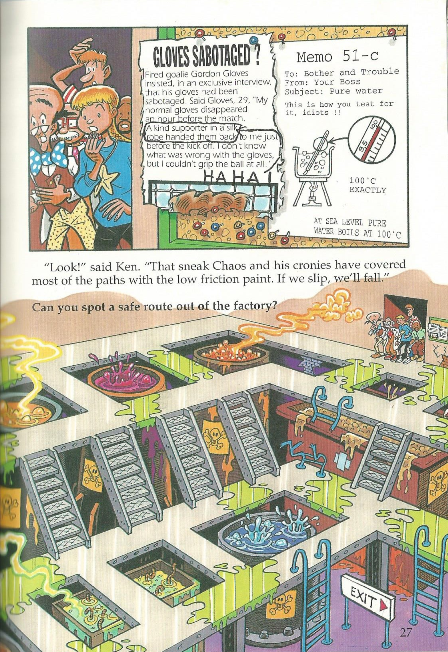
This is a damn insult and I take it personally.
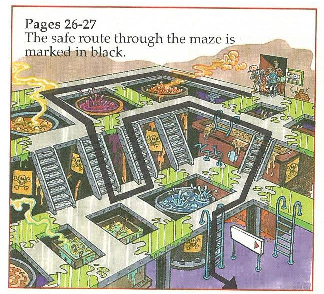
This is well below the level of anyone capable of understanding this book - and, needless to say, has nothing to do with science.

Oh, now they phone the police, not earlier, when they got a message about her being kidnapped. Would it hurt to have at least taken the precaution? …Though I am pleased to see that the first thing the rest of them are doing is pulling on fresh lab coats. While Dr. Genius decides on a new hat. Anyway, while the gang have done absolutely nothing useful, Suki has finished her friction restorer, confirming her status as most important character to be hardly a part of the story at all. While half of the Mad Scientists - curiously, despite the gender classification, not Elton, so I kind of wonder if the author forgot about him this time - bow their heads in shame over having wasted valuable supplies. Thinking about it, it probably helped Suki immensely that all of them vacated the premises and stopped getting into her marvellously horizontal hair.
Meanwhile, Dr. Genius remembers that he’s meant to be both the main character and the leader, so maintaining his recent development into the cryptic genius who’s always one step ahead, he hurries off on some unspoken but probably hare-brained plan to save the Blue Carnation Club from destruction. Not where I expected the plot to go, as clubs with names like that are usually evil in stories, but then again so are scientists in stories, and our heroes are merely stupid instead. Now, did you remember the whopping great unsubtle hint from just the previous page about how to tell pure water from any other colourless liquid? No, Ken, don’t just taste it! Nooooo -

Gotcha, book, you forgot to explain why this only works at sea level! The answer is that boiling occurs in relation to the surrounding atmospheric pressure, which is decreased at higher elevations, so water will boil at a lower temperature the higher you go, and vice-versa. Wow, it sure is easy to sound like a scientist if you have access to a search engine.
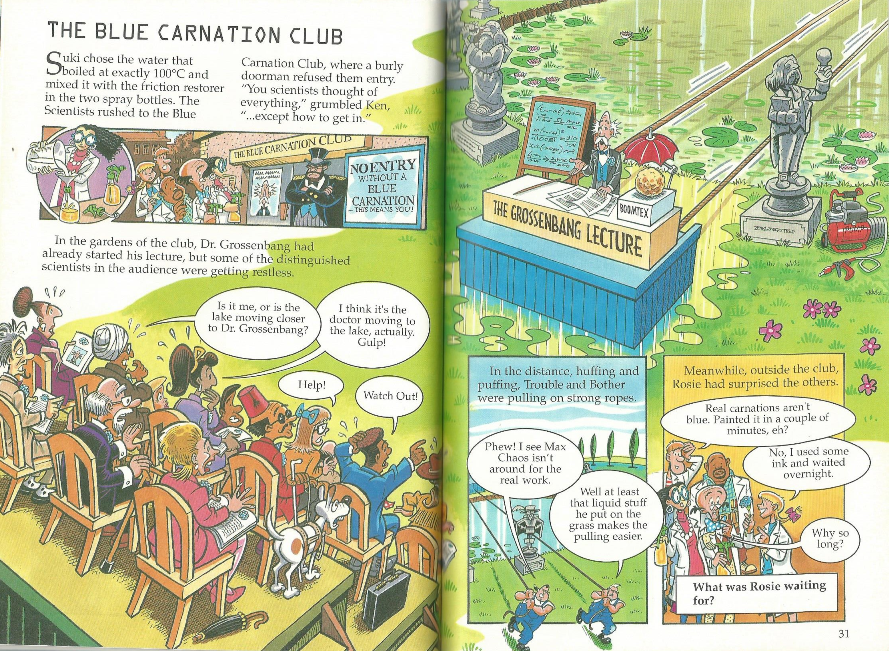
Oh for crying out loud. Where do I even start with this mess. Well, on the plus side, Ken gets some snark in against the Mad Scientists, and he’d have quite done my job for me if the scientists had, in fact, not thought of anything even approaching everything, and if he wasn’t also one of them. He drew a giant gun, he cocked and aimed it, and blasted a burning slug of lead directly into his own foot.
So let’s say you’re an eminent scientist giving a speech about why a dangerous substance that violently explodes on contact with water should be banned. Would you, in your genius and wisdom, not only bring along a sample of this material, but leave it exposed to the open air and then host your speech a few metres away from a lake? WHAT IS WRONG WITH THIS MAN. Like, he got it a tiny little brolly just in case the rain came down, let’s forget about the possibility that the wind could either slant the rain or blow the Boomtex away, since we’ve seen earlier on in the book that it’s extremely light - but he ignored the giant body of water directly behind the stage?! A gust of wind in the right direction and Max Chaos might have managed to avoid lifting a finger, the Blue Carnation Club would just destroy itself on its own!
Now, just look at this page, and think about Max Chaos’s plot and how it works. Essentially, he wants to dunk that Boomtex in the water and blow up the Blue Carnation Club. Sure, that’s fine. But rather than using, I don’t know, a hose, a water balloon, he has his henchmen tie ropes onto the back of the stage, which they are to use to pull the stage across the lawn and into the lake. So let me get this straight - nobody at the Blue Carnation Club either noticed that there were ropes attached to the stage leading off into the lake, Dr. Grossenbang just stepped right over them. Nothing suspicious here!
Oh, but it gets better. Ladies and gentlemen, on this page I present to you the spectacle of Clive Gifford forgetting how his own plot device works. The lawn underneath the stage is completely saturated with antifriction formula. Now, hold up here. We can clearly see that, just to get onto the stage, if there’s even anything under his feet at all, Dr. Grossenbang would have to step onto this stuff, but nope, no problems, he doesn’t slip on it at all. More than that, there is clearly no antifriction liquid on the stage itself, so in fact it must already have been there before the stage was constructed, so everyone who worked to put that stage in place, and then Bother and Trouble to attach the ropes to it, must have also been immune to the properties of the antifriction formula - or, alternatively, they all just sat there in place, after the lecture had begun, while Max Chaos soaked the ground all around the stage, right in front of them, with antifriction liquid, and nobody raised a fuss, nobody stopped him, and at the same time he didn’t take the opportunity to throw a bucket of water onto the Boomtex. But wait, there’s more - the antifriction liquid was stated earlier to have a terrible smell, but can anyone on this page smell it? The audience, the man giving the lecture? Either they can’t, or they’re ignoring it - but hold on, the theft of this liquid and its subsequent use for criminal activities made front-page news, and on top of that, these people are all top scientists devoted to protecting the environment, so how would they not have heard of the antifriction formula and its properties? And beyond all this, even if you account for all these plot holes somehow, there’s this: Why is it so difficult for Bother and Trouble to haul that stage into the lake? The whole point of the antifriction liquid is that it reduces friction to almost nothing. That big ol’ stage should be encountering zero resistance on the ground, it should’ve started slipping straight into the lake on its own after just a single tug on the ropes to lend it some starting momentum! And yet Bother and Trouble are clearly having to pull pretty much as hard as they would if there was no antifriction liquid on the ground at all! Not one part of this scenario, a big fat zero percent, none of it makes any sense!
…But the puzzle is based on scientific knowledge.
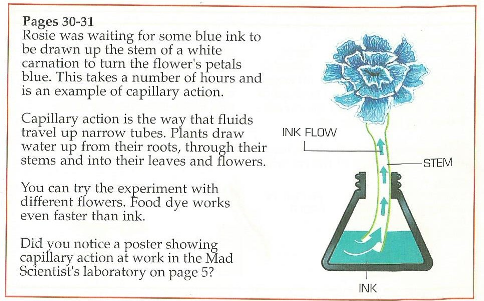
On the other hand, the puzzle requires us to assume that Rosie had already anticipated that she would have to gatecrash the Blue Carnation Club lecture since before the Mad Scientists went to Slickspin Labs. Isn’t it great when the plot only works because the author wanted it to?
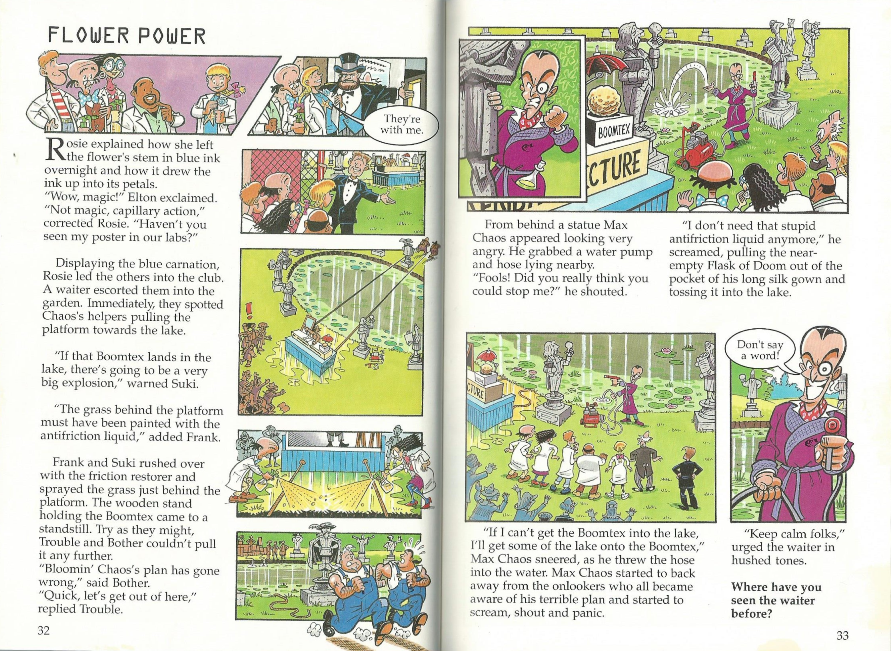
Max Chaos seems to agree with my criticisms of the previous pages, as he tosses away the plot device of the title - we’re only about three-quarters of the way through the book, by the way - and does exactly what I said he should’ve done all along and pulls out a hose to just hose the Boomtex down. Why he didn’t do that before, I don’t know; how he managed to cram himself behind a statue, I don’t know either, and nor do I know why. It’s pretty clear that that the Boomtex would have to produce quite a large explosion in order to take out the entire Blue Carnation Club, and in that range, it seems certain that Chaos would have died too if he was just behind the statues. Even now, he’s way closer to the Boomtex than the audience of the Blue Carnation Club, who I can only imagine are even now fleeing the scene and putting themselves even farther from danger! Well, far be it from me to criticise an environmental polluter for a self-destructive plan, but what I don’t understand is why Professor Grossenbang and the Mad Scientists haven’t just grabbed the stuff and tossed it out of the way already.
Now, if you please, identify this waiter. Why does a lecture need a waiter? No time for questions!
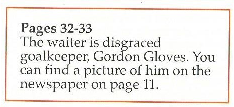
Man, he got that job quickly. Friend of a friend, I guess. I’m not entirely sure how he’s meant to help in this situation, though; can he catch water?

Nobody move! Let’s all give the villain time to step away from the explosive substance so he can safely kill us all, rather than running away while he’s still in range and couldn’t possibly do anything! Good grief, is it any wonder the planet’s not been saved yet? Also, wow, the top border of that top-left panel is really confused.
Fortunately, in this story, it’s not just the heroes who are incompetent, it is everyone. Poor Max Chaos. On succumbing to the temptation of all villains to boast and gloat rather than just getting on with it, he himself is counter-planned by a master… a master of knowing the story ahead of time. Even allowing for the not implausible advance knowledge that the Grossenbang lecture would involve a large sample of Boomtex displayed on the edge of a lake (it’s the advance knowledge that’s plausible, not the set-up) and putting two and two together, the mystery master apparently anticipated that the plot could only be defeated by hiding in the water in case there happened to be a hose nearby that the villain might use. …So, in other words, this man of mystery actually anticipated the villain doing the obvious thing rather than the convoluted thing. I mean, sure, this person could still have just removed the hose, or better yet, actually phoned in a warning… but I’ll let it pass simply for the sake of somebody having made a reasonable prediction.
By the way, do hoses without any water source fire pressurised air?

The snorkel was outright mentioned in the narration, so there goes that subtle clue. …And for the last time, he isn’t even that plump! Geez.
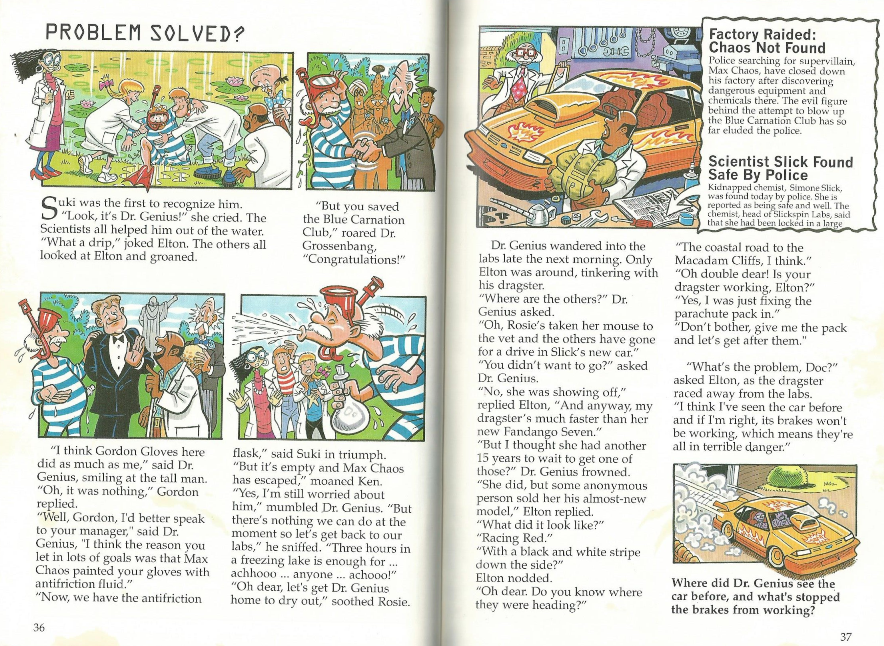
Good golly I cannot stand this Gordon Gloves character. He is shoehorned into the narrative to fulfil a function that nobody could have predicted, and then stands there with the smuggest expression known to man, all false modesty as everyone applauds him for being the most important person in the book. Also, how the heck was Dr. Genius in that lake for three hours? He shouldn’t have had a head-start of more than ten minutes on the other Mad Scientists; they only had to boil some water and then split the friction restorer into two spray bottles!
I need to cool my head. Let’s unwind a little by reading the newspaper, the favourite activity of all children who read puzzle books. Hmm, I see the police closed down Max Chaos’s factory because of all the safety hazards there, and not because he’s a criminal supervillain. Also, they actually managed to rescue Simone Slick. Now, a reminder that the Mad Scientists went into this adventure to: 1. Retrieve the antifriction formula, and 2. Rescue Simone Slick. Well, the first didn’t happen, and the second happened without any of their help whatsoever. So our heroes did none of the things they set out to do. Great job!
Anyway, we hit the dramatic climax of the story in the last couple of pages, but there are still more pages to fill, so quick, think up another new threat! Can you use careful observation and close reading to deduce the danger? Or basic knowledge of storytelling and mechanics?
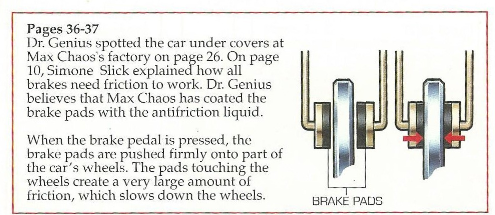
An actual diagram showing how brakes work pushes this answer into the realms of the decent, but here’s the thing I never get about the many, many works of friction where people’s brakes have been tampered with: How does nobody notice this immediately? When you’re driving, it’s not like you won’t be touching the brakes until ten minutes, twenty, an hour into your journey; you’ll be using them all the time, whenever you hit traffic, a turning, a corner! In real life if your brakes weren’t working when you started your car, you’d just rumble into a wall or a parked car at low speed after about twenty seconds, unless we’re being asked to believe that Simone Slick’s driveway faces directly into a long straight road to Macadam Cliffs with no traffic. And wait, where was this car when she was given it? Did they put it directly in her drive and this is the first time she’s used it?
I don’t ask for much.
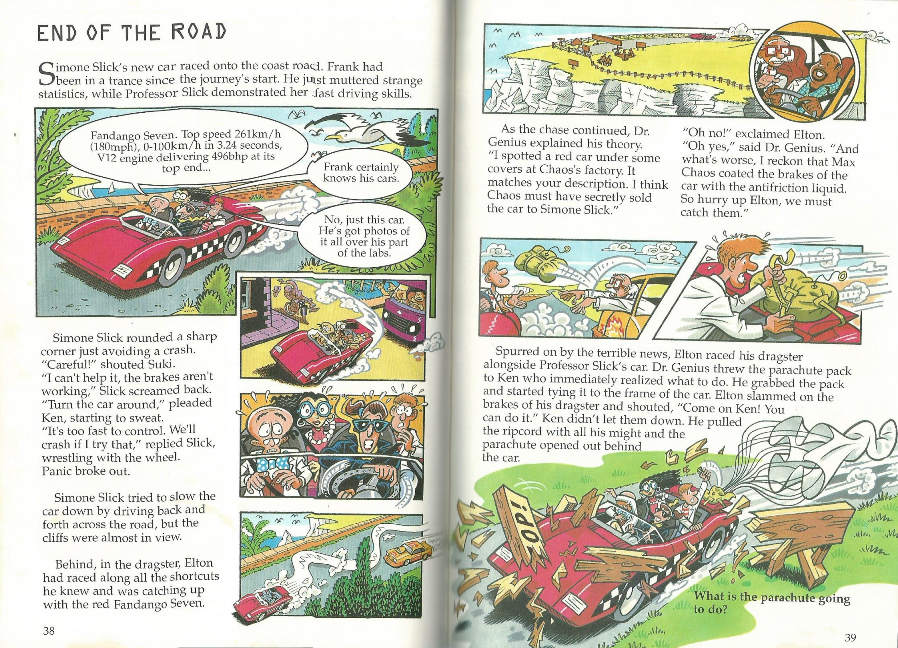
Okay, this is being handled better than I expected, with even some very sensible measures taken to slow the car down on its own - maybe the axles were also painted with antifriction liquid? I still have questions about whether Professor Slick has ever been in this vehicle before. And how long she’d been waiting for an opportunity to throw on the sunglasses, leather jacket and scarf. I am very much enjoying Suki’s hair blowing at almost complete right-angles to the wind, though. Even Ken’s hair is only affected in a single panel! Frank… has our commiserations, I’m sure.
Anyway, if you checked page 10 to understand brakes for the previous puzzle, then surprise surprise, you can solve this puzzle too! …Generously defining “puzzle” here, I mean it’s a puzzle only to the extent that a science test is a puzzle.

Will it create enough friction to stop them in the second before they plunge off that cliff, though? …Where was that road even meant to lead, anyway. It’s just a long straight road that drops straight off a cliff at the end. Can you tell what this is a metaphor for? (Usborne English Puzzle Adventures would’ve been amazing.)
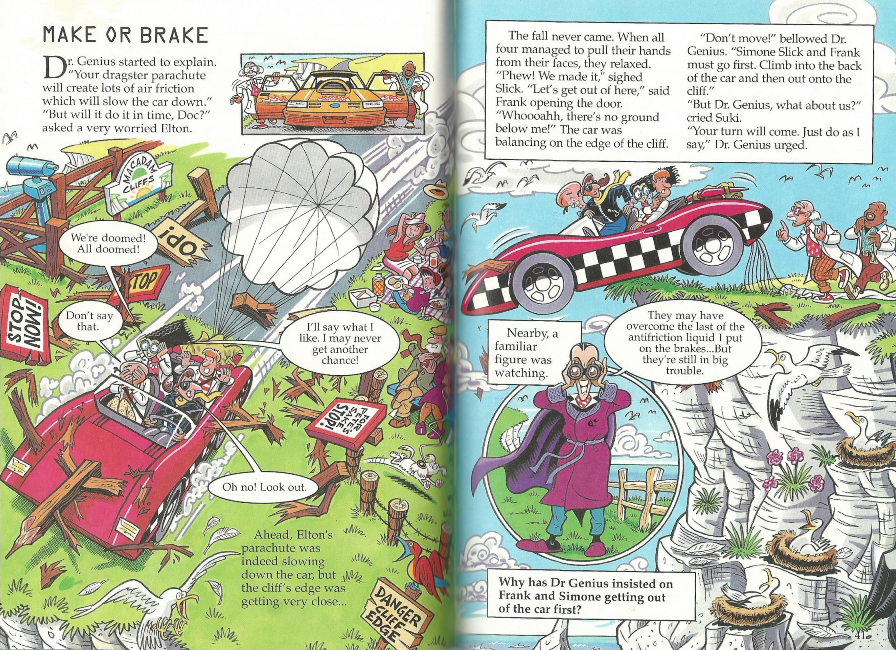
Gasp! I’m shocked at this turn of events! A double-page that is actually really, really well-illustrated! Seriously, no criticisms here, this is beautiful. It has action dynamic character posing and packs in the detail and uses a broad colour palette. More of the book should have been like this. I guess Geo Parkin was saving himself for the end.
Meanwhile, Max Chaos compensates for his recent defeat by adding an actual cape to his villainous ensemble. He didn’t need to be here, he couldn’t possibly have known when and where everyone else would be here, but he gambled on the possibility of being able to show off his cape, and it paid off.
And the last puzzle in the book involves actual science, in the form of physics. And a cliffhanger! Just send me off with warm fuzzy feelings, why don’t you, you cynical swines.
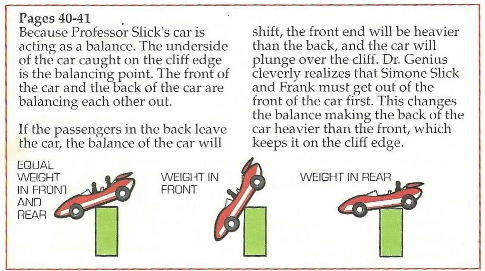
Frank and Simone suffer a very narrow escape here, as it’s all too easy to imagine Ken in particular just shoving open his door and scrambling out without waiting for anyone. Well, in fairness, Frank is the most redundant member of the Mad Scientists - seriously, he only solved one puzzle that wasn’t even in his field, and both Clive Gifford and Geo Parkin forgot to include him on the first visit to Slickspin Labs - and, despite getting a significant amount of screentime, Professor Slick isn’t even one of the group. They wouldn’t be missed. Oh well!
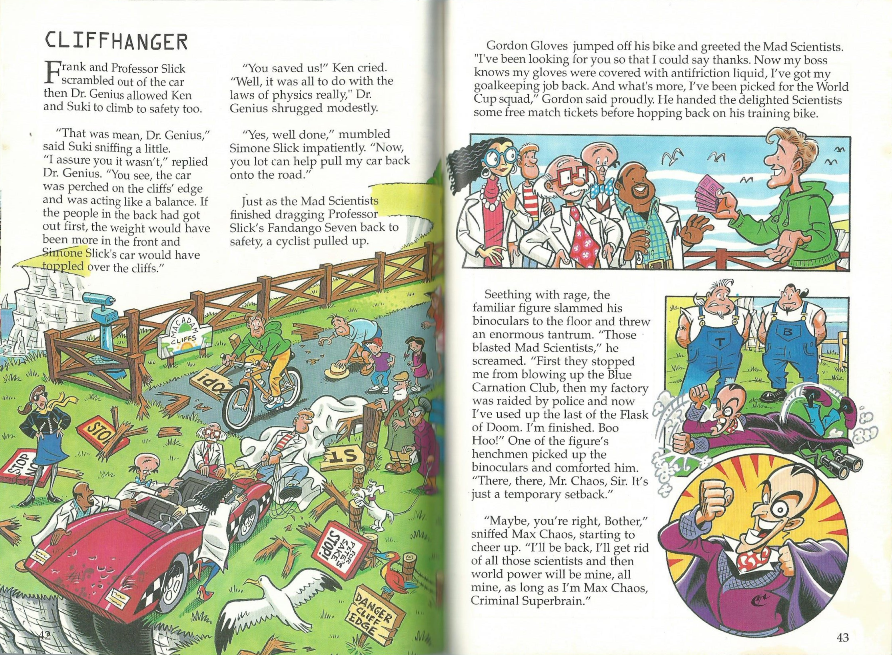
Just a reminder, given that Dr. Genius attributes the rescue here to the laws of physics - the book lists Frank’s job as being a physicist. This guy is dead weight. Meanwhile, Gordon Gloves returns with tickets to the World Cup for the Mad Scientists! Because if there’s one thing that kids who read science puzzle books love, it’s football. …Wait, there are only five tickets there. Clive Gifford wrote Rosie out of the end of the book for some reason, so Geo Parkin forgot to draw in a sixth ticket for her. What a team!
It’s kind of hard to believe Max Chaos used up the entirety of that second Flask of Doom - yeah, we all saw it in his back pocket when he tried to sabotage the Blue Carnation Club, and it was clear from the bank robbery that he had more than just the one flask - on just those brakes, but maybe he was blinded by revengelust and poured the lot of it on. Still, never fear, Max Chaos. You’re still a clichéd villain with an outfit which has, amazingly, only gotten more ludicrous. A defeat like this isn’t the end, since the police haven’t actually captured you or really set you back all that far at all. You’ll be back! Oh wait, there was only one more book in this series, and you aren’t in it. You won’t be back. The end!
…I know I gave this book a hard time, and a lot of people would say to that, “relax, it’s just for kids.” And on one level then yeah, sure, I’m criticising it because it’s funny - but at the same time, does anyone really believe that kind of response is sufficient? That just because something is for children we shouldn’t bother taking them seriously as an audience, but should just write down the first thing that comes into our heads without caring if it makes any sense or meets their requirements? I don’t think that’s adequate. This is a science puzzle book for children. It needs to be three things: Scientific, puzzling, and funny. I challenge anyone to say that this couldn’t have been done better.
But still, there’s no way they could make the same mistakes twice… right?
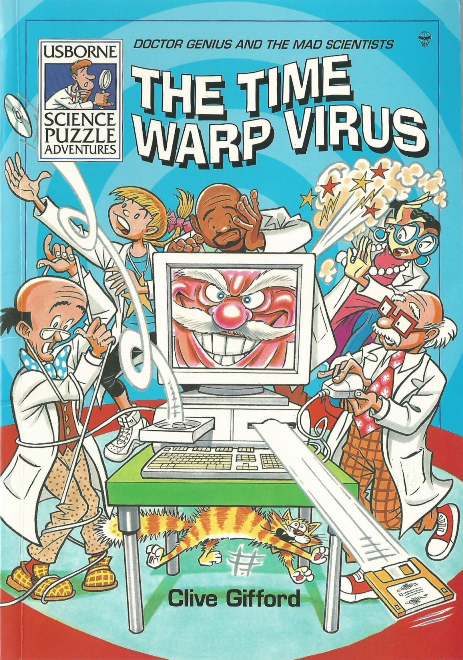
Also, by my reckoning a good third or so of the puzzles in this book were not science puzzles.
NEXT TIME: Let’s do the Usborne again.
The awkwardly- and lengthily-titled Usborne Science Puzzle Adventures came, like Usborne Solve It Yourself, around the time the original Usborne Puzzle Adventures series drew to a close - 1996. As I’ve speculated before, Usborne had pretty much saturated the market with its original thirty-odd Puzzle Adventures, so the chances are they were on the lookout for anything they could spin as new and exciting and original. Enter Clive Gifford, author of a heck of a lot (like seriously, hundreds) of educational and puzzle books for children, who whether by commission or on his own account produced two books headlined “Doctor Genius and the Mad Scientists,” which were made into the inaugural titles in the new Usborne Science Puzzle Adventures series.
Unfortunately for Gifford and Usborne, these ended up being the only books in the Usborne Science Puzzle Adventures series. We can only speculate about what happened, but given that these books sell themselves as both Usborne Science Puzzle Adventures and Doctor Genius and the Mad Scientists, it’s a fair bet they were only meant to be the first of various USPA sub-series by different authors. But clearly, it didn’t take off. Let’s see if we can determine just why things didn’t work out.

Maybe it’s only me, but just for starters I don’t find the updated, much cartoonier and goofier art style particularly appealing. Graham Round’s rather rough-edged and idiosyncratic artwork of the early Usborne Puzzle Adventures really made those books; Peter Wingham’s art back on The Dark, Dark Knight was tolerable, but there’s something very manufactured and designed-by-committee about Geo Parkin’s work here. I’m also not a big fan of the “let’s just not bother to include a background” school of design. It’s functional enough, I guess. We can reasonably infer that those goofs in the back are our heroes, Doctor Genius and his Mad Scientists, which is usually the sort of name you’d give to a bunch of villains but nope, as we’ll find out, the carefully-individualised Mad Scientists are definitely the heroes here. At least we have a villain with some class. Monocle, ascot... uh, that’s probably meant to be a monogrammed smoking jacket but it looks a lot more like a dressing gown, let’s be honest. This is a villain who gets that dreadful modern ennui where one doesn’t see anything going on in the day that’s worth getting dressed for. Only 90s kids will get this.

Fiendish mastercriminal Max Chaos! Hahaha, wow. There is not one thing remotely subtle about any of the words in that phrase, either individually or together. Credit where credit’s due, they tell us exactly what we’re in for. Also credit where credit’s due, the premise of the antifriction liquid is actually fairly original, if not even remotely doom-laden, and you can easily see how it ties into the (sshh, whisper it) educational aspect, because yes, surprise, these are secretly educational books! Probably nobody ever learned anything useful from Escape from Blood Castle or Who Shot the Sheriff? - at least, I hope not - but the aspirations of Usborne Science Puzzle Adventures were not disguised very well. Maybe that’s why they didn’t succeed, perhaps; too obviously educational, no matter how thrilled they sounded about being “the first book in an exciting new series of adventure stories”.
Still, let’s give them a chance. After all, Dr. Genius and the Mad Scientists need your help! Because not one of them is smarter than a ten year old.

I checked my old files, and not one of these people worked on any of the previous Usborne puzzle books I’ve documented. They even threw out series editor and author of the early books Gaby Waters! Even Who Shot the Sheriff? had her on the team! The classics may have been silly as anything, but they at least had charm. Oh well, at least there’s some of that classic Escape from Blood Castle flavour of seeing our protagonists captured and tied up. Even though they clearly outnumber the villains more than twice over. You’d think they could at least split up and run away.

At last, it’s time to meet our five heroes! …Our six heroes! Bizarrely, Suki Beaker is completely missing from both the front and back covers and the title page. I really don’t know why they’ve tried to erase her, but there it is. Way to fall at the first hurdle on representation, Usborne.
Anyway! These are our six heroes, covering a broad spectrum of gender, ethnicity, body type, even age. It is all very convenient but we shall not choose to question it. What we should probably question is their actual commitment to science. Sure, the interdisciplinary approach has a lot going for it, but the upshot is that every one of them is working with five other people who know absolutely nothing about their field, apparently even less than the man on the street. Not only do I know one end of a car from another, just about, I can also tell a cat from a kangaroo. Somebody should let me onto this team. Oh, right, they kind of have, I’m the reader and the person who solves all their problems for them. This is handy, as these people are so incompetent that I don’t even know how their lab stays open. The story openly admits that they never actually complete any of their projects, so frankly I assume one of them must already be rich for their lab to have any funding at all. Either that, or they’re getting money under the table from tobacco companies or Big Pharma. But that seems unlikely, as fighting crime appears to be the one thing they are good at. Shame it doesn’t pay the bills.
At any rate, here they all are, carefully-profiled with jobs and interests, and we’ll just see how many of those interests ever actually come up in the story. Will Dr. Genius ever actually collect any antiques or sleep in late? …Does Dr. Genius even have a formal position at this laboratory? “Leader” isn’t a job or a scientific specialism, and nor is it the best person on the team to be sleeping in late all the time. Well, he is getting on a bit, I suppose.
Frank Quark is a ruthless sportsman and gambler who likes playing chess and winning bets. Okay, probably he’s the one keeping the Mad Scientists afloat, then.
Elton Bolt likes dragster racing and fishing, presumably not at the same time. Don’t both of these interests go at completely different paces? Then again I guess you could say the same for Quark’s hobbies of reading and fast cars, so I guess I’ll let it slide.
Rosie Bloom’s interests are all conceivably biology-related, so no complaints there.
Suki Beaker - chemistry, cooking, okay, but… mountain biking? These are some pretty active scientists. Well, when you spend all your time fighting crime instead of performing experiments, it means you end up doing a lot of fieldwork.
Ken Plank is a lab assistant, and considering what this lab is like, either he’s the most useless of all of them or the smartest of the lot. Incidentally, on the cover of the second Usborne Science Puzzle Adventures, he displaces Dr. Genius in the series title box. Still could be either the smartest or most useless.
…Also, I just realised that Dr. Genius is the only one of these idiots with an actual doctorate. Is this even a real laboratory? Are these people qualified?
Also, by the way, as the bottom of page 3 implies, we’re not getting hints this time around, just answers. But I liked the hints! Well, I guess they often are either not helpful at all or too helpful by half. Still, it’s just one more step away from the tried-and-tested formula which, no matter how much I mocked it, I deeply enjoyed. Ah well. Let’s see how this goes.

Like Suki’s even the most important character on the first real page, what the heck. Dr. Genius barely says anything. Though the real star of the show is Dr. Quark’s incredibly smug expression… though we will later see that this book is very good at, if anything at all, smug expressions.
One sunny morning, our heroes can’t tell that it’s sunny or morning as they’re cooped up in a windowless lab engaged in that most scientific of scientific pursuits, petty gambling. Petty gambling right next to the experiment involving a legally controversial explosive substance. Suki runs in to tell Dr. Genius something, but the Boomtex was her experiment, so she’s just left the dangerous explosive material lying around unattended in a precarious position, in the vicinity of the very chemical which causes it to explode. I can’t wait for the third title in the series, Dr. Genius Versus The Safety Inspectors Of Closure!
Before we proceed with the puzzle, let us first appreciate the amount of detail packed into the background of this scene. The pictures of fast cars and wild animals. A poster for their favourite club. And, just in case this was sounding too much like a teenager’s bedroom, litmus paper, swiftly explained and doubtless to be crucial to some future puzzle. As for this page’s puzzle, it’s more or less a… well, not a tutorial, but more of a test. Do you know one of the most basic and commonly-known scientific details about water?
Oh. Or you could just recognise the bucket full of clear fluid and cheat, I guess.

Water is the answer. The thing which Suki has seen which she thinks will make the Boomtex explode is water, as explained on the opposite side of the page. To the book’s credit, “Dr. Genius Explains” is a good title for this section as the reason why water’s chemical formula is H2O is clearly explained rather than just stated without context, so good on it. If they’d wanted to be really clever, they could have tricked you here and had a substance which looks like water but actually has a different chemical name, and that’s why it’s just what Suki thinks she’s seen - but she’s a chemist, she knows what she’s doing, unlike everyone else, who don’t. And thus the book proceeds with its first explosion. That’s sure to appeal to the kids!

Don’t worry, though, the explosion was of no consequence whatsoever, it was merely a humorous interlude before we get onto more hard science, including rendering the answers page more or less immediately redundant.
Suki continues to be the most important character despite not being featured anywhere on the cover by revealing that she is the inventor of the almighty antifriction formula which this book is all about, and which it is apparently a big deal to have the only flask of stolen, despite the fact that they can just make more, and if they can’t then what made them think it would be so easy to turn into an internationally successful product? Simone Slick clearly has some money to splash around, given that she owns a chemistry lab, is on the waiting list for a super fasto posh beep beep vroom vroom speedywheels, and can afford to wear a pair of glasses about the same size as her entire head. Here, have a geography quiz. Geography is like science, right?

The way I learnt it is that Indian elephants have ears shaped like India, and African elephants have ears shaped like Africa. Note also that the basic outline of that tiger is identical to the one pictured on page 5, so I’m guessing Geo Parkin only had the one reference image. …It also occurs to me that this puzzle is totally irrelevant to the plot, but it was the end of a double-page so we had to have one.
I wonder how many pages it will be before we meet a character who isn’t wearing a lab coat?

Oh, no more. Here they are. Max Chaos sure didn’t hang about when it came to entering the narrative. He didn’t even bother to get dressed; look, he’s still in his slippers.
I admit, Max Chaos’s goofy, absurd, slapstick plan tickles me. I like it a lot. It feels like something out of the 1960s Batman or something equally camp. So I will overlook obvious logical problems like why the bank had no form of panic button, backroom staff, passers-by, any way of alerting the police to what is a fairly public robbery that would have taken some time to complete until after the comically-named thieves have departed. I won’t even complain that Max Chaos’s fake gun becomes meaningless the moment he fires it - why didn’t they jump him then, and what does he plan to do when the next bank he robs already knows he doesn’t have real weapons? It could’ve at least squirted more antifriction formula - and for that matter, antifriction liquid that can make people fall over isn’t exactly my idea of a “Flask of Doom.” But no. I will overlook these things for the sake of the joke.
What I will not overlook is the fact that, once again, the puzzle in question isn’t based on science. It’s mathematics.

I cracked it as 60 x 90, myself, but you get the picture. Say, couldn’t they have called for help from passers-by? But I already said I would let it slide. I don’t have a choice. With that antifriction liquid in play, of course everything’s going to slide!

Meanwhile, back at Slickspin Labs, the scientific experts are still being given a lecture on basic friction. Then they’re told to get lost. Maybe they should come back when they all have actual doctorates. It’s very noble of Rosie to eschew the reward money, but university doesn’t come cheap these days!
Over the page, Suki continues to be the most important character in this story as an old man grumbles over what he reads in the newspaper. Dr. Genius, remind me why this is your problem again? Suki, why are you giving the impression that the only reason you care about this is because you feel personally insulted by Professor Slick? She has an actual degree. Leave this to the professionals, please. Max Chaos is clearly having a whale of a time, though. He really is a genius. Only one day later, and he’s already successfully gotten away with two separate wicked schemes, much though the hard-hitting investigative journalism of The News Herald can’t make the connection between a stolen antifriction formula and a top international goalkeeper with butterfingers, and also a dreadful team who let a whole twenty-one goals get near him in the first place. Okay, maybe Max Chaos isn’t the only problem here.
Whoops, we’ve hit the end of a page. Time to shoehorn in an insultingly easy puzzle that still has nothing to do with science.

Professor Slick gets results. Less than twenty-four hours and she’s already nailed that friction restorer. See, Suki, this is what you could do if you had actual qualifications. Also she’s being kidnapped by people who are polite enough to permit her to leave a series of undoubtedly cryptic clues which she can’t simply send in a fax because reasons. First-draft puzzle, first-draft plot…
Also, while I cannot claim to have spent time in many offices while the fax machine was still relevant, wouldn’t it make as much or more sense if the printer trouble was on the Mad Scientists’ end…?

Rather than calling the police, the Mad Scientists decide to investigate the kidnapping-in-process by entering a darkened building at midnight. What did they expect to happen, honestly. They didn’t even turn the lights on. Meanwhile the pungent odour of the Flask of Doom has been swiftly downgraded, the better for our heroes to fall quite literally into a trap - albeit one which makes no sense according to the orientation of the rooms as depicted in the panels, which show that Professor Slick’s office lies at the end of a long straight corridor which not only slopes downwards but has a flight of stairs at the end and no turn-offs within which a villainous henchman could hide to subsequently close the door behind the Mad Scientists without themselves being caught in the antifriction formula. But I didn’t read this book to nitpick. (I absolutely read this book to nitpick.)
Oh by the way, Suki’s out of the story again because she’s working on the friction restorer, and in fairness, while she’s late to the party on that, the fact that the sole inventor of the friction restorer has just been kidnapped right after finishing it suggests that it might not be around anymore. (Alright, probably the henchmen had some friction restorer, and that’s how they got to the door to close it on the Mad Scientists. Quit nitpicking my nitpicking! It’s rude.)
Anyway, finally a puzzle which requires some knowledge of biology… although the real a puzzle why the ransackers threw the lamp around but didn’t touch the plants that indicate its location. Actually, I’m not even sure there’s room for the lamp where it’s clearly originally supposed to have gone…

All the plants? I guess the cactus might just about to be said to be doing so, but we can’t really tell about the daffodils. I guess that’s clutching at straws, though; they’re probably meant to be red herrings to make the actual solution slightly less obvious. The important thing is that we learned something. Although in fact you can only have learnt something if you were unable to solve the puzzle, but if you could solve it already then you didn’t learn anything. This is the main flaw of this sub-series; its actually scientific puzzles are more a test of whether you already know something or not, and whether you do or you don’t then it’s not really a puzzle as there is nothing much to really work out…

I have a vague idea that I was confused by this whole scenario of the hidden key when I was a child, because there was clearly nothing where the lamp should have been except floor - but the key is, of course, hidden under a floor tile. I assume Rosie only figuratively “ripped” the carpet up, given that Professor Slick had been using that spare just the previous day. Presumably her real keys were not lost but stolen by Max Chaos and his gang as they waited for her to complete the friction restorer, a theory substantiated by their subsequent ability to lock the Mad Scientists in, but if that’s the case, would she really have hidden them again?
Anyway, despite coming all this way to visit Professor Slick’s office, we now leave her office, walk back over the harmless antifriction formula, and snoop around Slick’s lab to gaze enviously at her high-tech equipment. Wow, turns out that, if you actually sell your amazing inventions, you can afford top-of-the-line equipment which allows you to perform more sophisticated experiments with more refined results! Pfft, no real scientist cares about that rubbish, clearly. More and more I think Dr. Genius and his gang are just being funded by corporate interests…
As Rosie marvels at paper coffee mugs and I reflect that even scientists with more academic qualifications than Dr. Genius still need element flash cards, we are asked to puzzle out the meaning of this clue, presumably one of the ones Dr. Slick carefully hid whilst struggling with her kidnappers. We might as well, as I’m not sure what everyone else is meant to be doing. So, what does this piece of paper tell the Mad Scientists? Well… how to make the friction restorer, I guess? Is that answer allowed? No, because it’s wrong.
Now, I’ll ‘fess up that on my rereading here I messed up this puzzle pretty hard, primarily because I kind of forgot how Venn diagrams work, despite really liking Venn diagrams. But I was just so convinced that part of the puzzle of this page involved working out what the battery acid was, as the element flashcards appeared to clearly direct you to the Lithium poster on pages 4-5; there’s even a little arrow pointing you to the battery acid on the note, and the water is also muddied by the fact that there are very clearly not nine-hundred-and-ninety-nine flasks in the room. (In fact, the room the Mad Scientists are in right now is completely irrelevant to the plot - they could be in a corridor.) So I really thought this was some set of instructions, whereby if you combine 999 of all the flasks with these specific acids pictured then voila… but if that were the correct reading, the two circles would have to overlap completely, I think, because it would require all of both sets rather than a subset of each, which is the real solution here.

So. You have 999 flasks on the wall, 999 flasks, you take one down and pass it around and if it’s an acid then it’s friction restorer. Still, I do think there are a lot of very odd things about this puzzle - the obviously false specification of 999 flasks, for instance, bearing in mind that neither the illustrations nor the narration have yet presented us with a room filled to bursting with flasks, and indeed which won’t turn up for another couple of pages. Similarly, I think there’s the redundancy of the fact that each set is both labelled and illustrated, which implies that the details are important when in fact they aren’t at all (yet). On top of that, there’s the way that the puzzle only really boils down to “It’s an acid,” which makes all the rest of the flasks redundant… A lot of the trouble just boils down to the puzzle only making sense in the context of an area we haven’t seen yet but don’t know that we haven’t seen yet. …Insert funny comment here?

It doesn’t happen very often, but the next two pages each contain an independent puzzle (sort of), so we’re taking them in turn. Incidentally, it’s interesting, from a point of view of plot construction, when Usborne Puzzle Adventures have to give away the solution to a puzzle on the very following page. Sometimes the answers are just too specific to disguise, but a lot of the time it’s possible to write over it. Not here.
So, we have a not very subtle clue, but ignore that for a minute, because the real puzzle is on the other side of the blackboard. Thanks for stumbling across it, almost literally, Dr. Genius! Let’s not just mention that it would have been equally easy to discover this tricky puzzle just by, you know, walking around the blackboard, which is in the middle of the room. Rosie and Ken are clearly side-on to it, you’d have thought they could see that there was something on the other side as well, even if it was upside-down. Oh - but I keep forgetting, it’s actually a fundamental point of their characterisation that our heroes are complete idiots. Makes a change! (I also note here that the text describes Dr. Genius as “stout,” but his build is actually very similar to everyone else save Elton, which makes me wonder how close a conference there was between the author and illustrator on this one.)
You’ve probably done puzzles like this before. It’s a simple rebus puzzle - an introductory one, really, as every stage directly clues you in to the fact that we’re actually thinking about the words these images represent. I do think it’s faintly classless that, once again, part of it depends upon a place we haven’t heard of yet. Also that, in the context of the previous puzzle, this puzzle is once again quite unnecessary.

You see my point, right? We’ve never heard of a testing room, and for that matter, I wouldn’t begrudge anyone who didn’t know much about test tubes to read the first part of the middle line as “TUBE,” leaving you with a puzzle about a ting room. They couldn’t have slipped a reference to test tubes somewhere earlier in the story? In a book about scientists? Wait, what did this puzzle have to do with science again. Just that it had a test tube in it…?

Of course, the easy way to solve this puzzle is to let your eyes slide slightly to the right, where we get the answer straightaway, and since this puzzle is once again not about science then it’s fitting that the answer is delivered by the character who knows the least about science. So he’s useful for something!
They just had nothing for this page, though, did they. Not only did they have to split these two pages up into two puzzles, they had to basically give the answer away. We could have been spared being reminded about the other side of the blackboard, which we first saw about a minute ago. We could’ve stood for the elements on the silly keypad to be ones without really obvious chemical symbols that you could feasibly just ignore. The only one you couldn’t flat-out guess is which element the P stood for.

I’d say that it was a nice job for actually hiding lithium way back in the book… but it’s negated this being the first time we’ve ever read the name “Professor Bunsen.” Do they proofread these things at all?

Here’s where the 999 flasks come in. Six by eight, forty-eight, so probably around twenty sets of shelves total, twenty-one - no, twenty-two - to account for the remainder… If they were planning on storing near-on a thousand flasks, I’d have thought they’d have gone for a five by ten model. Wait, hold on, one of the illustrations shows the shelves are double-sided, so that’s ninety-six per shelf for eleven sets of shelves. Okay, that’s actually a lot more mangeable than I figured, you could fit all this in a much smaller room than I had anticipated. Especially when I realised that I’d multiplied an extra ten into my original equation and thought there were over two hundred sets of shelves… It’s a good thing these aren’t Usborne Maths Puzzle Adventures! Which didn’t exist, but I’d have snapped them up if they did. But I guess they’d only have been all about science. And speaking of science, what makes this a “testing room” again?
The door slams yet again. You ever get the feeling our heroes are maybe being herded around just a bit? A bit fishy, especially considering it seems unlikely, after all, that the villains have the friction restorer after all, since it appears to be hidden in this room. What villains hang around the scene of a kidnapping despite almost certainly suspecting that their victim had alerted people on the outside? Villains who know full well that the Mad Scientists aren’t nearly practical enough to think about calling the police, that’s who.
I’d really like to complain about the contrivance of the outrageous stroke of fortune our heroes suffer on this page, but… you know, if the friction restorer was jammed onto the shelves at the last minute as a hiding-place, I guess it might be a bit off-balance. Though frankly it looks like a bit of a casualty of design as much as anything else, as one good bump’d to any of those shelves would be enough to bring down nearly a hundred chemicals. I guess Slickspin Labs are no more practical-minded than the Mad Scientists…
Anyway, you know how litmus paper works. Even if you didn’t and hadn’t read anything in the rest of the book, the page once again basically explains itself. No wonder they didn’t put any hints in the back!

Pretty basic stuff, let’s hurry onto the inevitable capture of our gullible heroes.

Well, what a surprise. (Incidentally, the art on the title page isn’t just recycled from any of the images here or on a future page, indicating that the illustrator knowingly redrew not two but three separate pictures that ignored one of the book’s main characters. Good job!) As you will have surmised, this is one of many, many stories in which the villain relies on the idiot heroes to do all his work for him, which in this instance means solving puzzles. Now, I personally thought there was a real chance Simone Slick was working for Max Chaos and that was how she’d had time to leave all these subtle-as-anything clues, but no, the deception was the obvious one, and our heroes walked right into it, as heroes always do.
Not that Max Chaos seems all that much more competent than everyone else. The fact that he thinks world domination is achievable puts him straight into the realms of clichéd insanity. He boasts about destroying that friction restorer (whoops, I guess the villains didn’t already have it after all, so those plot holes from earlier are back), but you’d have thought it might be handy for him to have some defence against his own superweapon, and more than that, you’d have thought if he intended to destroy it he’d just throw it on the floor rather than holding onto it and walking about with yet another flask clutched tight in the hand he isn’t using to smoke, though it now occurs to me that the fact that someone is smoking in a children’s book dates this thing more than anything else in the story. What’s in that cigarette, anyway. Is it some substance which accounts for Max’s rigid, manic grin? Well, at least he’s enjoying himself, even if he hasn’t noticed that out here in the real world nobody with real power is lifting even a finger to stop the world’s biggest chemicals and arms manufacturers from doing whatever they want. Funny jokes!
Now, let’s have another puzzle which isn’t strictly speaking related to science, though I guess you can make an argument that detail-oriented observation to gather empirical evidence is of the most fundamental scientific import. Whatever you believe, please comb through this page for a tiny background detail which is so easy to overlook that it’s almost like an art mistake. No, it’s not Chaos’s supply of spare costumes, though Frank could pull off a wizard impersonation if you asked me. No, it’s not Ken’s bizarre needle-soled shoes. Nor is it the hidden trick for distinguishing which henchman is Trouble and which is Bother. It’s actually the kind of puzzle I quite like in an Usborne Puzzle Adventure, really.

Please. Suki is far too proud to accept such shortcuts.

Okay, I’ll give Geo Parkin this. He was asked to draw the worst-looking factory in the world, and boy, did he deliver. The amount of detail crammed into this page is on a par with some of the better pages of Escape from Blood Castle. Fair play to him, he did a good job. With that said, I would question the Mad Scientists’ idea of what makes an awful factory. You know what I see here? Zero workers. Nobody is being underpaid, exploited, and exposed to dangerous conditions here. Well, our heroes aside, but it’s not like they’re here to work, they’re just here to die. I mean, be imprisoned forever. It’s an interesting choice of imprisonment. The magnetic qualities of steel are, in the first place, somewhat variable depending on its composition, and if the cage isn’t fixed to the floor then with a certain amount of wriggling about then the Mad Scientists could probably just push it over. So, the death trap is about as secure as the rest of the factory, then? Also, please note that if that crane is such a powerful magnet, then it should also have had a strong magnetic effect upon anything metal upon our heroes’ bodies. I hope Dr. Genius doesn’t have a pacemaker.
Now that the villains have left our heroes to their own devices in an unbelievably dangerous setting, this seems like the best time for the lead character to be unnecessarily cryptic.

The solution is based upon scientific principles, and was established earlier in the story? At last, things are starting to look up for this book!

Now that the ropes are off, I feel this is a good time to mention, again to his credit, that Geo Parkin kept the orientation of the Mad Scientists in the rope bundle entirely consistent, even in the out-of-sequence illustration on the title page. (He’s been consistent with which side Chaos’s monocle is on, too.) With that said, his choice did betray some favouritism, as Dr. Genius and Rosie were nearly always centre-stage, but to be honest, they’re my favourite designs too… but so is Elton, and he’s just been a hemisphere for the past few pages. This design choice coincides with Elton’s brain being elsewhere, too, as he reveals that he could have freed them all at any time. Our heroes! Again! They are not very good at what they do. Also, despite Frank’s boast that he was responsible for them getting away with this trick, he was infuriated at the start of the book when Elton beat him at his own game, so in actuality he was totally unnecessary to this escape effort.
Suddenly a fire erupts that’s conveniently between the Mad Scientists and the exit! Actually, I say “conveniently,” but if you look back at the previous page you’ll see that Geo Parkin thought of that too and set up a slightly improbable way of timing it to start at just the right time and place. In fact, this whole illustration is consistent with the previous page, just drawn from another angle - so it’s not even recycled art! Maybe this could still become a good book after all. Now, Rosie, if you could just introduce how fire burns and then squeal uselessly when someone tries to directly remove one of the things necessary for a fire to burn.

The… fire triangle? Never heard of it, but apparently it’s a thing. Sounds like a less glamorous Ring of Fire, or possibly a musical instrument for daredevils. Hmph, back in my day we didn’t need a triangle to teach us about fire - wait, this book is from back in my day.

Everyone except Dr. Genius sacrifices their scientific credentials to the flames, and not a moment too soon. They also sacrifice their most important clue for defeating Max Chaos, completely invalidating a previous puzzle. Clap. Clap. Clap. Truly stunning work, as always. How many evil plots had these people defeated in the past, did you say? Oh, you didn’t? How surprising.
(By the by, this page too has a subtle hidden detail that’s bound to be important later, so don’t miss it.)
Now, you’re probably wondering why I’ve only shown the one page here. Before we get to the next page, I’d like to talk about mazes for a minute. Mazes are one of my favourite kinds of puzzle from the many children’s puzzle books I read when I was young. Below is a maze from Escape from Blood Castle. Mazes are an opportunity for an illustrator to demonstrate their particular talents and style. Even without another puzzle laid on top of it, this maze would be challenging on visual detail alone.

And below here is a scan from an excellent maze puzzle book, Animal Mazes, that I owned as a child and still possess a copy of. It’s no coincidence that it’s another Usborne book, but as you can probably tell from the text, it is pitched at a younger age group than The Flask of Doom. The mazes of this book are majestic and overwhelming. When you get a book like this as a child, it changes you. They don’t make them like this anymore.

Here’s a maze from The Puzzling Puzzles, a supplementary volume to Lemony Snicket’s A Series of Unfortunate Events. …Okay, perhaps this isn’t quite so legitimate as it first appears - but there is still a genuine goal and a genuine challenge, if you look for it.

…And below is the 27th page from Usborne Science Puzzle Adventures #1: Dr. Genius and the Mad Scientists - The Flask of Doom.

This is a damn insult and I take it personally.

This is well below the level of anyone capable of understanding this book - and, needless to say, has nothing to do with science.

Oh, now they phone the police, not earlier, when they got a message about her being kidnapped. Would it hurt to have at least taken the precaution? …Though I am pleased to see that the first thing the rest of them are doing is pulling on fresh lab coats. While Dr. Genius decides on a new hat. Anyway, while the gang have done absolutely nothing useful, Suki has finished her friction restorer, confirming her status as most important character to be hardly a part of the story at all. While half of the Mad Scientists - curiously, despite the gender classification, not Elton, so I kind of wonder if the author forgot about him this time - bow their heads in shame over having wasted valuable supplies. Thinking about it, it probably helped Suki immensely that all of them vacated the premises and stopped getting into her marvellously horizontal hair.
Meanwhile, Dr. Genius remembers that he’s meant to be both the main character and the leader, so maintaining his recent development into the cryptic genius who’s always one step ahead, he hurries off on some unspoken but probably hare-brained plan to save the Blue Carnation Club from destruction. Not where I expected the plot to go, as clubs with names like that are usually evil in stories, but then again so are scientists in stories, and our heroes are merely stupid instead. Now, did you remember the whopping great unsubtle hint from just the previous page about how to tell pure water from any other colourless liquid? No, Ken, don’t just taste it! Nooooo -

Gotcha, book, you forgot to explain why this only works at sea level! The answer is that boiling occurs in relation to the surrounding atmospheric pressure, which is decreased at higher elevations, so water will boil at a lower temperature the higher you go, and vice-versa. Wow, it sure is easy to sound like a scientist if you have access to a search engine.

Oh for crying out loud. Where do I even start with this mess. Well, on the plus side, Ken gets some snark in against the Mad Scientists, and he’d have quite done my job for me if the scientists had, in fact, not thought of anything even approaching everything, and if he wasn’t also one of them. He drew a giant gun, he cocked and aimed it, and blasted a burning slug of lead directly into his own foot.
So let’s say you’re an eminent scientist giving a speech about why a dangerous substance that violently explodes on contact with water should be banned. Would you, in your genius and wisdom, not only bring along a sample of this material, but leave it exposed to the open air and then host your speech a few metres away from a lake? WHAT IS WRONG WITH THIS MAN. Like, he got it a tiny little brolly just in case the rain came down, let’s forget about the possibility that the wind could either slant the rain or blow the Boomtex away, since we’ve seen earlier on in the book that it’s extremely light - but he ignored the giant body of water directly behind the stage?! A gust of wind in the right direction and Max Chaos might have managed to avoid lifting a finger, the Blue Carnation Club would just destroy itself on its own!
Now, just look at this page, and think about Max Chaos’s plot and how it works. Essentially, he wants to dunk that Boomtex in the water and blow up the Blue Carnation Club. Sure, that’s fine. But rather than using, I don’t know, a hose, a water balloon, he has his henchmen tie ropes onto the back of the stage, which they are to use to pull the stage across the lawn and into the lake. So let me get this straight - nobody at the Blue Carnation Club either noticed that there were ropes attached to the stage leading off into the lake, Dr. Grossenbang just stepped right over them. Nothing suspicious here!
Oh, but it gets better. Ladies and gentlemen, on this page I present to you the spectacle of Clive Gifford forgetting how his own plot device works. The lawn underneath the stage is completely saturated with antifriction formula. Now, hold up here. We can clearly see that, just to get onto the stage, if there’s even anything under his feet at all, Dr. Grossenbang would have to step onto this stuff, but nope, no problems, he doesn’t slip on it at all. More than that, there is clearly no antifriction liquid on the stage itself, so in fact it must already have been there before the stage was constructed, so everyone who worked to put that stage in place, and then Bother and Trouble to attach the ropes to it, must have also been immune to the properties of the antifriction formula - or, alternatively, they all just sat there in place, after the lecture had begun, while Max Chaos soaked the ground all around the stage, right in front of them, with antifriction liquid, and nobody raised a fuss, nobody stopped him, and at the same time he didn’t take the opportunity to throw a bucket of water onto the Boomtex. But wait, there’s more - the antifriction liquid was stated earlier to have a terrible smell, but can anyone on this page smell it? The audience, the man giving the lecture? Either they can’t, or they’re ignoring it - but hold on, the theft of this liquid and its subsequent use for criminal activities made front-page news, and on top of that, these people are all top scientists devoted to protecting the environment, so how would they not have heard of the antifriction formula and its properties? And beyond all this, even if you account for all these plot holes somehow, there’s this: Why is it so difficult for Bother and Trouble to haul that stage into the lake? The whole point of the antifriction liquid is that it reduces friction to almost nothing. That big ol’ stage should be encountering zero resistance on the ground, it should’ve started slipping straight into the lake on its own after just a single tug on the ropes to lend it some starting momentum! And yet Bother and Trouble are clearly having to pull pretty much as hard as they would if there was no antifriction liquid on the ground at all! Not one part of this scenario, a big fat zero percent, none of it makes any sense!
…But the puzzle is based on scientific knowledge.

On the other hand, the puzzle requires us to assume that Rosie had already anticipated that she would have to gatecrash the Blue Carnation Club lecture since before the Mad Scientists went to Slickspin Labs. Isn’t it great when the plot only works because the author wanted it to?

Max Chaos seems to agree with my criticisms of the previous pages, as he tosses away the plot device of the title - we’re only about three-quarters of the way through the book, by the way - and does exactly what I said he should’ve done all along and pulls out a hose to just hose the Boomtex down. Why he didn’t do that before, I don’t know; how he managed to cram himself behind a statue, I don’t know either, and nor do I know why. It’s pretty clear that that the Boomtex would have to produce quite a large explosion in order to take out the entire Blue Carnation Club, and in that range, it seems certain that Chaos would have died too if he was just behind the statues. Even now, he’s way closer to the Boomtex than the audience of the Blue Carnation Club, who I can only imagine are even now fleeing the scene and putting themselves even farther from danger! Well, far be it from me to criticise an environmental polluter for a self-destructive plan, but what I don’t understand is why Professor Grossenbang and the Mad Scientists haven’t just grabbed the stuff and tossed it out of the way already.
Now, if you please, identify this waiter. Why does a lecture need a waiter? No time for questions!

Man, he got that job quickly. Friend of a friend, I guess. I’m not entirely sure how he’s meant to help in this situation, though; can he catch water?

Nobody move! Let’s all give the villain time to step away from the explosive substance so he can safely kill us all, rather than running away while he’s still in range and couldn’t possibly do anything! Good grief, is it any wonder the planet’s not been saved yet? Also, wow, the top border of that top-left panel is really confused.
Fortunately, in this story, it’s not just the heroes who are incompetent, it is everyone. Poor Max Chaos. On succumbing to the temptation of all villains to boast and gloat rather than just getting on with it, he himself is counter-planned by a master… a master of knowing the story ahead of time. Even allowing for the not implausible advance knowledge that the Grossenbang lecture would involve a large sample of Boomtex displayed on the edge of a lake (it’s the advance knowledge that’s plausible, not the set-up) and putting two and two together, the mystery master apparently anticipated that the plot could only be defeated by hiding in the water in case there happened to be a hose nearby that the villain might use. …So, in other words, this man of mystery actually anticipated the villain doing the obvious thing rather than the convoluted thing. I mean, sure, this person could still have just removed the hose, or better yet, actually phoned in a warning… but I’ll let it pass simply for the sake of somebody having made a reasonable prediction.
By the way, do hoses without any water source fire pressurised air?

The snorkel was outright mentioned in the narration, so there goes that subtle clue. …And for the last time, he isn’t even that plump! Geez.

Good golly I cannot stand this Gordon Gloves character. He is shoehorned into the narrative to fulfil a function that nobody could have predicted, and then stands there with the smuggest expression known to man, all false modesty as everyone applauds him for being the most important person in the book. Also, how the heck was Dr. Genius in that lake for three hours? He shouldn’t have had a head-start of more than ten minutes on the other Mad Scientists; they only had to boil some water and then split the friction restorer into two spray bottles!
I need to cool my head. Let’s unwind a little by reading the newspaper, the favourite activity of all children who read puzzle books. Hmm, I see the police closed down Max Chaos’s factory because of all the safety hazards there, and not because he’s a criminal supervillain. Also, they actually managed to rescue Simone Slick. Now, a reminder that the Mad Scientists went into this adventure to: 1. Retrieve the antifriction formula, and 2. Rescue Simone Slick. Well, the first didn’t happen, and the second happened without any of their help whatsoever. So our heroes did none of the things they set out to do. Great job!
Anyway, we hit the dramatic climax of the story in the last couple of pages, but there are still more pages to fill, so quick, think up another new threat! Can you use careful observation and close reading to deduce the danger? Or basic knowledge of storytelling and mechanics?

An actual diagram showing how brakes work pushes this answer into the realms of the decent, but here’s the thing I never get about the many, many works of friction where people’s brakes have been tampered with: How does nobody notice this immediately? When you’re driving, it’s not like you won’t be touching the brakes until ten minutes, twenty, an hour into your journey; you’ll be using them all the time, whenever you hit traffic, a turning, a corner! In real life if your brakes weren’t working when you started your car, you’d just rumble into a wall or a parked car at low speed after about twenty seconds, unless we’re being asked to believe that Simone Slick’s driveway faces directly into a long straight road to Macadam Cliffs with no traffic. And wait, where was this car when she was given it? Did they put it directly in her drive and this is the first time she’s used it?
I don’t ask for much.

Okay, this is being handled better than I expected, with even some very sensible measures taken to slow the car down on its own - maybe the axles were also painted with antifriction liquid? I still have questions about whether Professor Slick has ever been in this vehicle before. And how long she’d been waiting for an opportunity to throw on the sunglasses, leather jacket and scarf. I am very much enjoying Suki’s hair blowing at almost complete right-angles to the wind, though. Even Ken’s hair is only affected in a single panel! Frank… has our commiserations, I’m sure.
Anyway, if you checked page 10 to understand brakes for the previous puzzle, then surprise surprise, you can solve this puzzle too! …Generously defining “puzzle” here, I mean it’s a puzzle only to the extent that a science test is a puzzle.

Will it create enough friction to stop them in the second before they plunge off that cliff, though? …Where was that road even meant to lead, anyway. It’s just a long straight road that drops straight off a cliff at the end. Can you tell what this is a metaphor for? (Usborne English Puzzle Adventures would’ve been amazing.)

Gasp! I’m shocked at this turn of events! A double-page that is actually really, really well-illustrated! Seriously, no criticisms here, this is beautiful. It has action dynamic character posing and packs in the detail and uses a broad colour palette. More of the book should have been like this. I guess Geo Parkin was saving himself for the end.
Meanwhile, Max Chaos compensates for his recent defeat by adding an actual cape to his villainous ensemble. He didn’t need to be here, he couldn’t possibly have known when and where everyone else would be here, but he gambled on the possibility of being able to show off his cape, and it paid off.
And the last puzzle in the book involves actual science, in the form of physics. And a cliffhanger! Just send me off with warm fuzzy feelings, why don’t you, you cynical swines.

Frank and Simone suffer a very narrow escape here, as it’s all too easy to imagine Ken in particular just shoving open his door and scrambling out without waiting for anyone. Well, in fairness, Frank is the most redundant member of the Mad Scientists - seriously, he only solved one puzzle that wasn’t even in his field, and both Clive Gifford and Geo Parkin forgot to include him on the first visit to Slickspin Labs - and, despite getting a significant amount of screentime, Professor Slick isn’t even one of the group. They wouldn’t be missed. Oh well!

Just a reminder, given that Dr. Genius attributes the rescue here to the laws of physics - the book lists Frank’s job as being a physicist. This guy is dead weight. Meanwhile, Gordon Gloves returns with tickets to the World Cup for the Mad Scientists! Because if there’s one thing that kids who read science puzzle books love, it’s football. …Wait, there are only five tickets there. Clive Gifford wrote Rosie out of the end of the book for some reason, so Geo Parkin forgot to draw in a sixth ticket for her. What a team!
It’s kind of hard to believe Max Chaos used up the entirety of that second Flask of Doom - yeah, we all saw it in his back pocket when he tried to sabotage the Blue Carnation Club, and it was clear from the bank robbery that he had more than just the one flask - on just those brakes, but maybe he was blinded by revengelust and poured the lot of it on. Still, never fear, Max Chaos. You’re still a clichéd villain with an outfit which has, amazingly, only gotten more ludicrous. A defeat like this isn’t the end, since the police haven’t actually captured you or really set you back all that far at all. You’ll be back! Oh wait, there was only one more book in this series, and you aren’t in it. You won’t be back. The end!
…I know I gave this book a hard time, and a lot of people would say to that, “relax, it’s just for kids.” And on one level then yeah, sure, I’m criticising it because it’s funny - but at the same time, does anyone really believe that kind of response is sufficient? That just because something is for children we shouldn’t bother taking them seriously as an audience, but should just write down the first thing that comes into our heads without caring if it makes any sense or meets their requirements? I don’t think that’s adequate. This is a science puzzle book for children. It needs to be three things: Scientific, puzzling, and funny. I challenge anyone to say that this couldn’t have been done better.
But still, there’s no way they could make the same mistakes twice… right?

Also, by my reckoning a good third or so of the puzzles in this book were not science puzzles.
NEXT TIME: Let’s do the Usborne again.